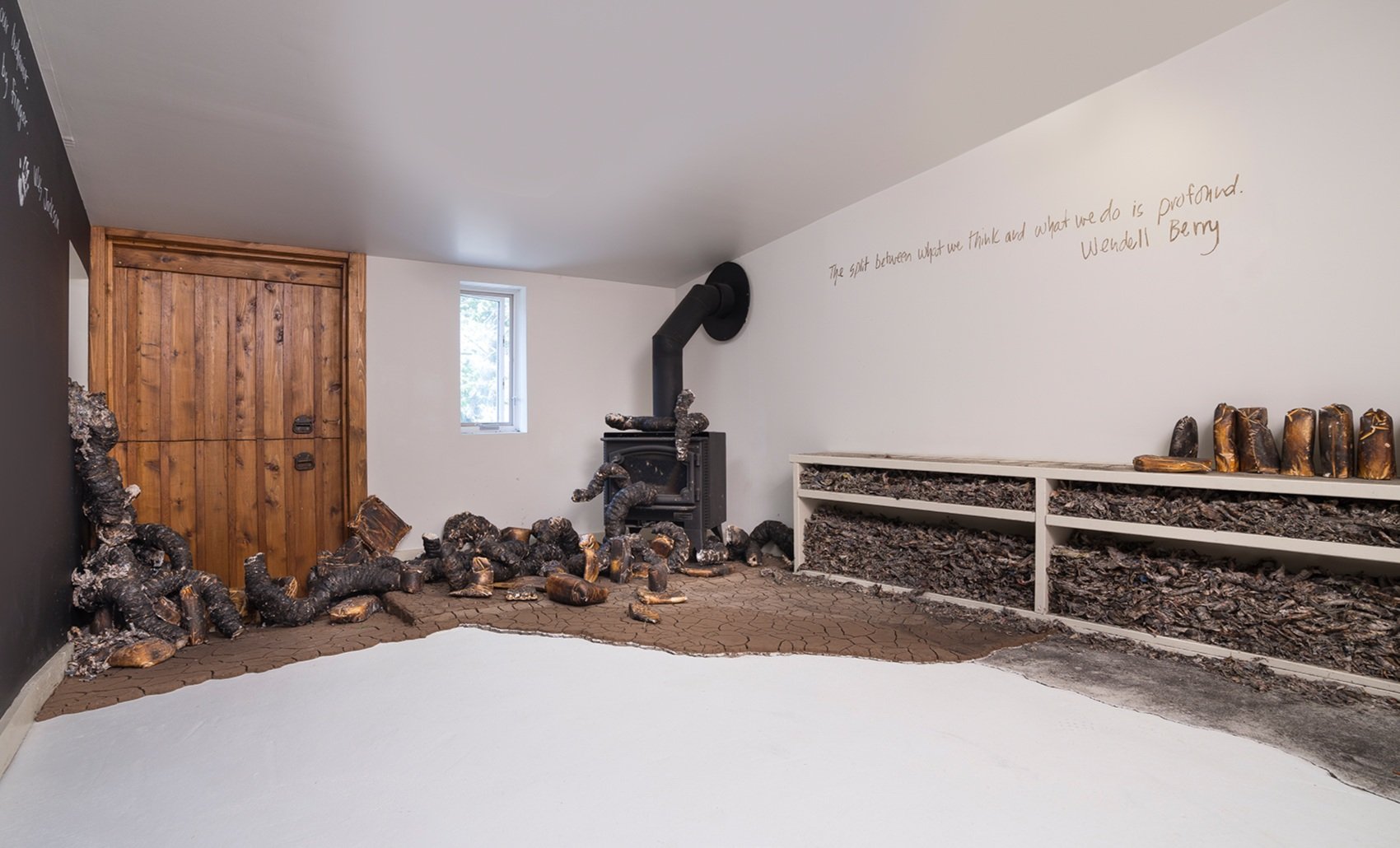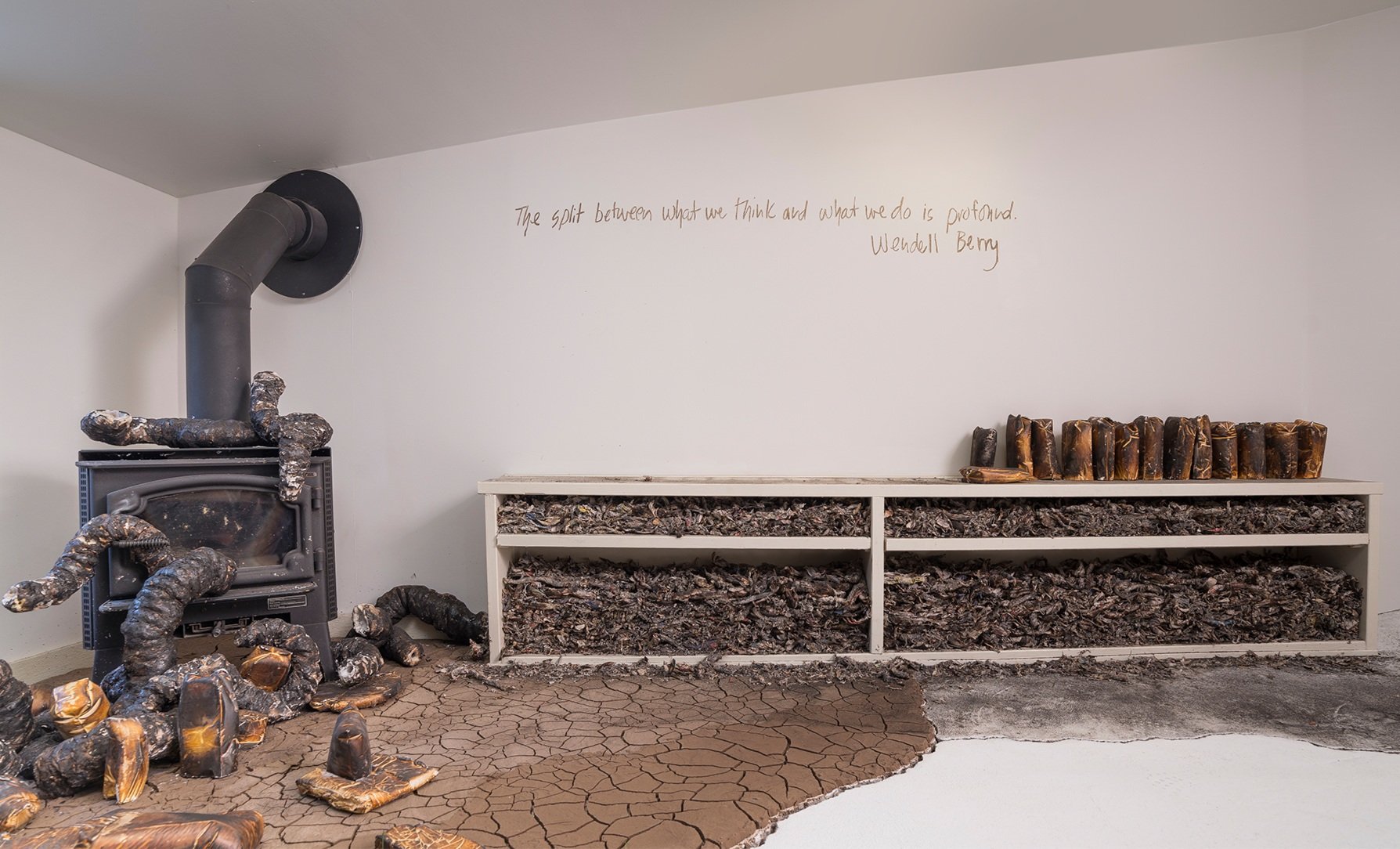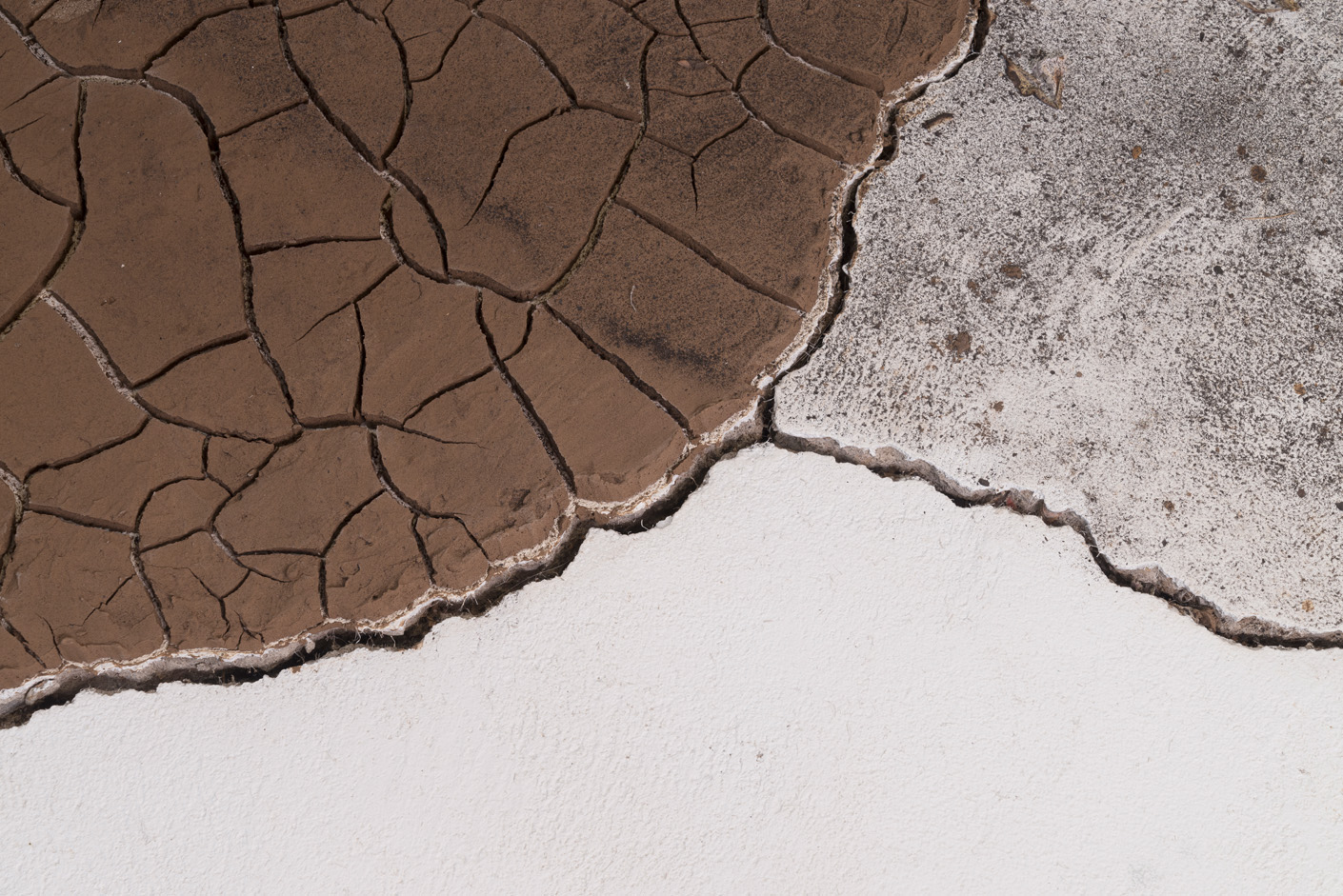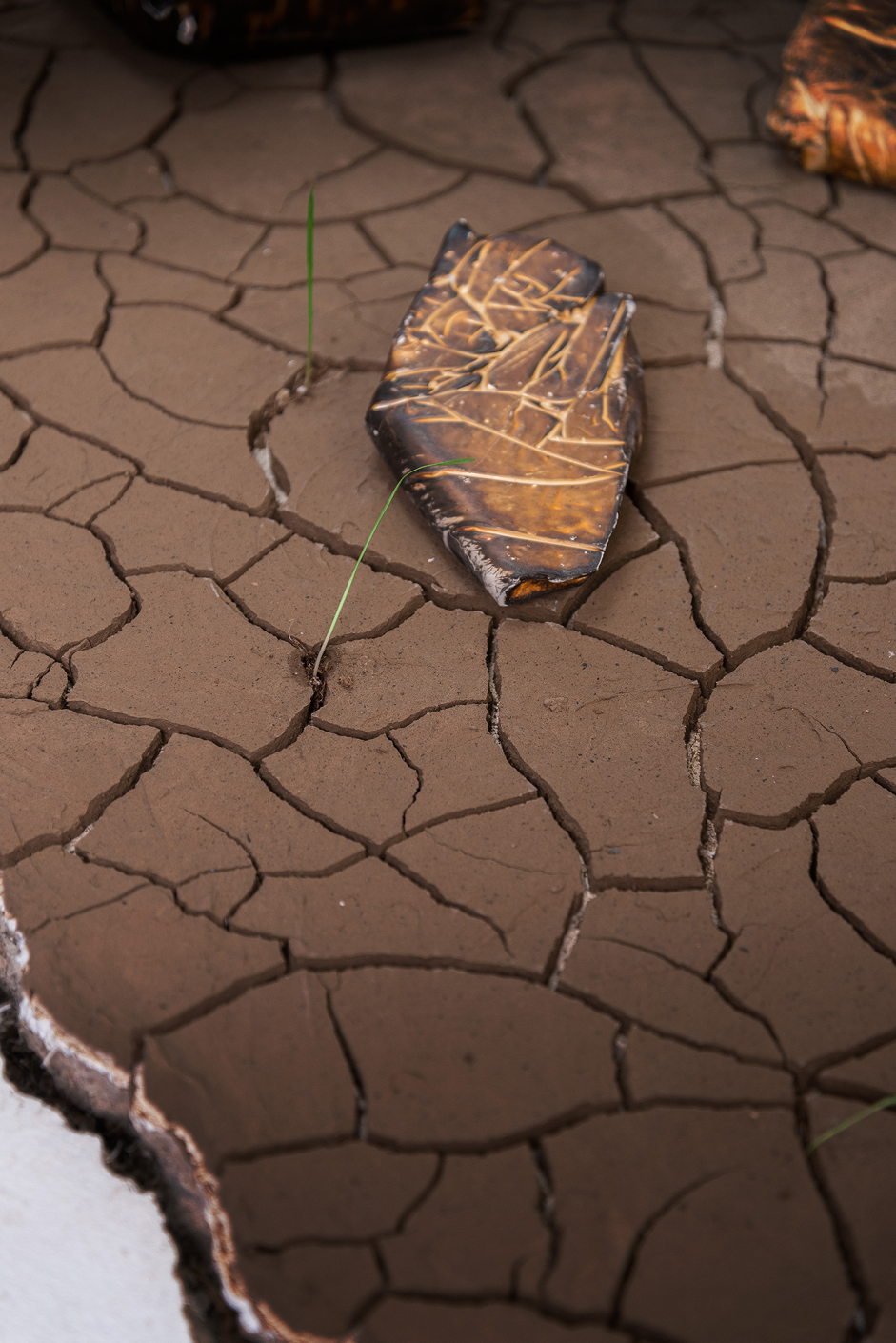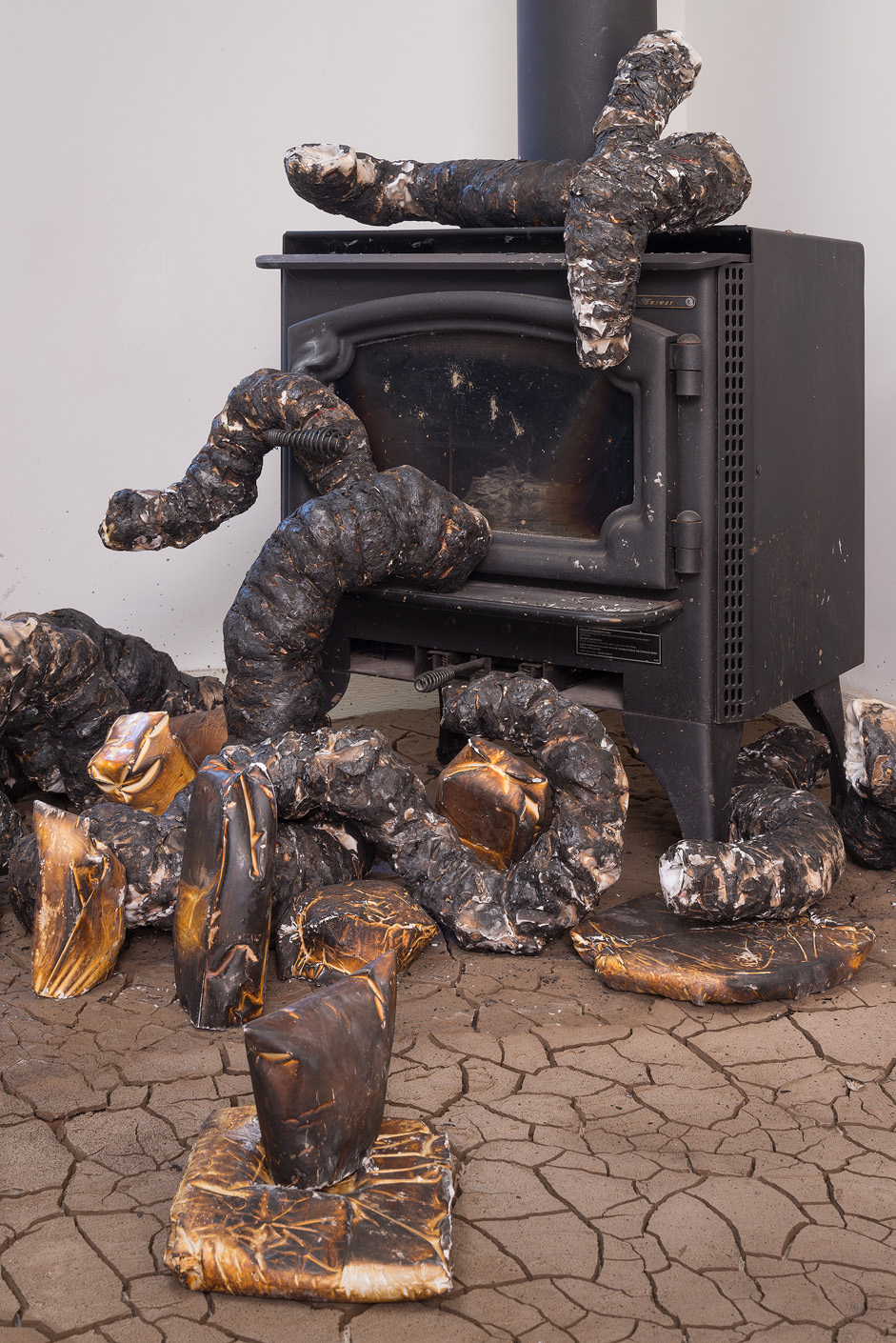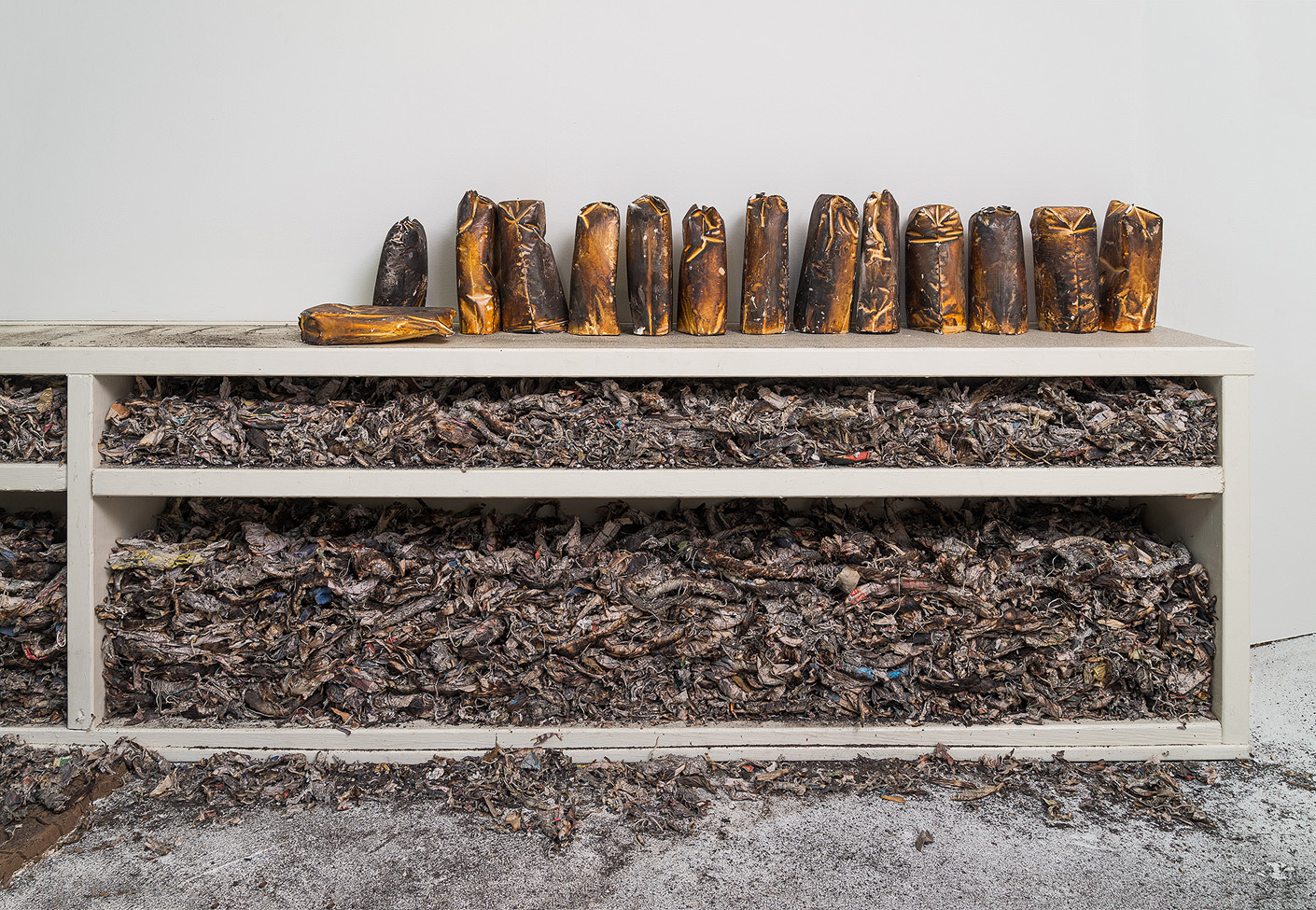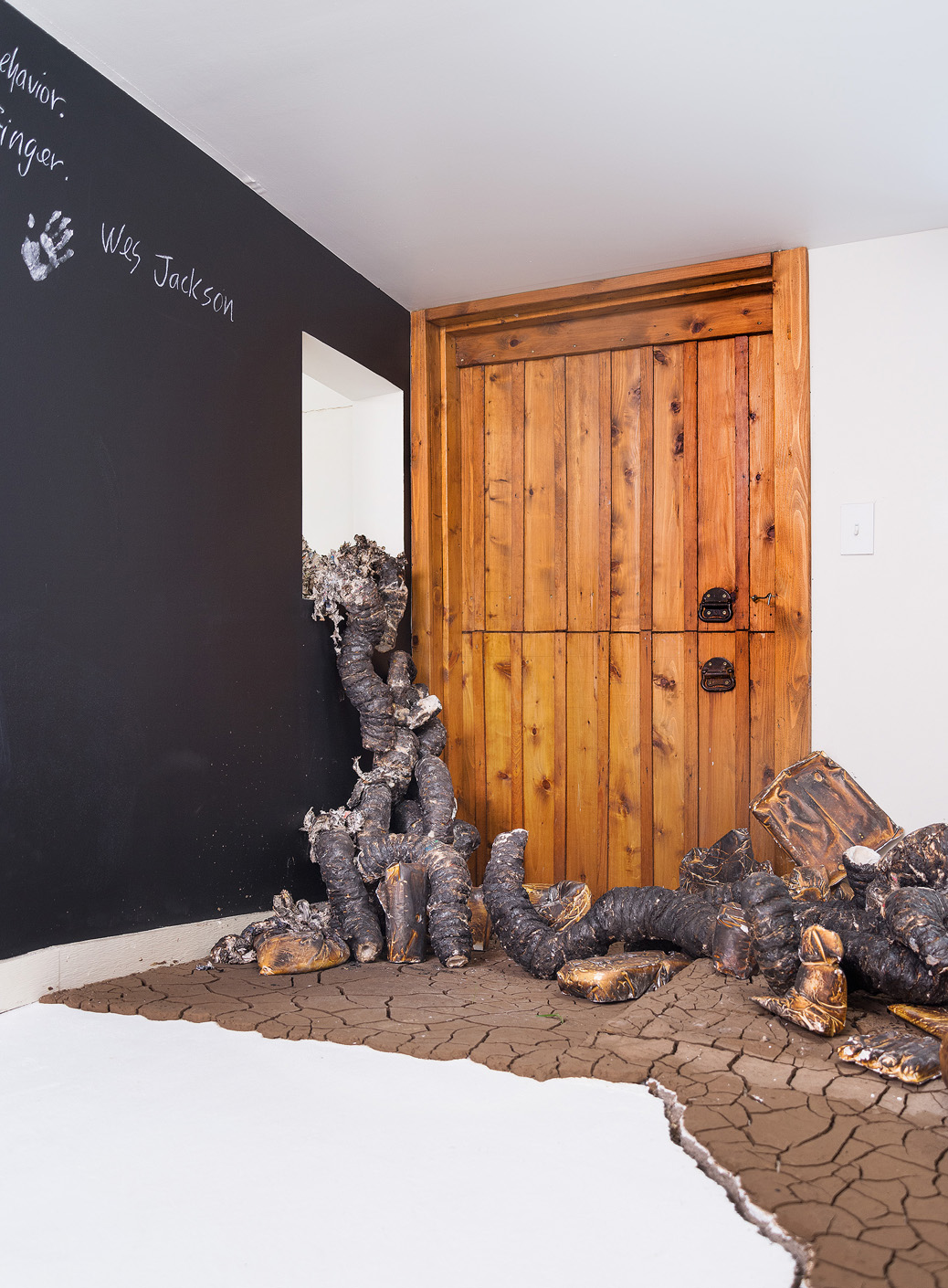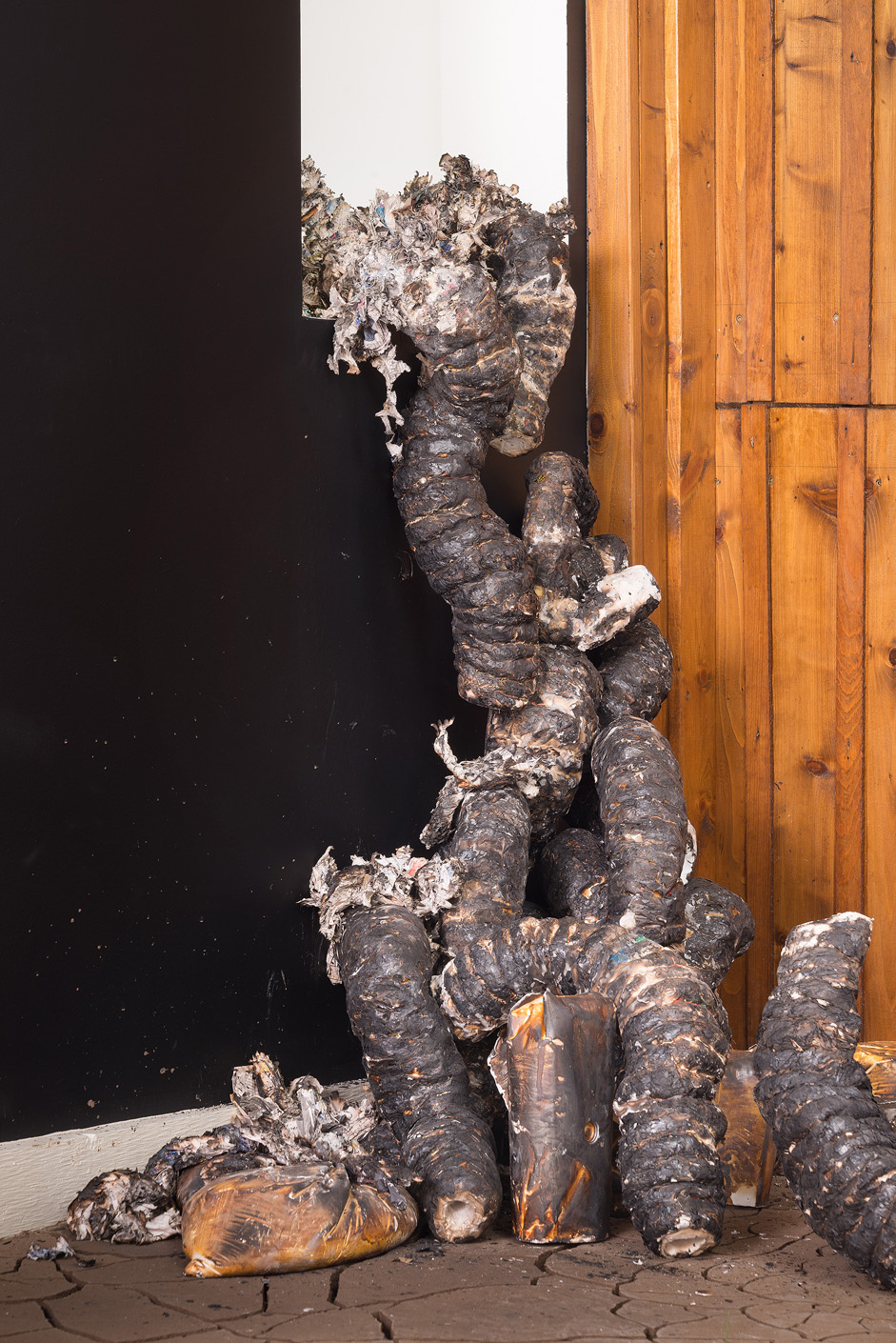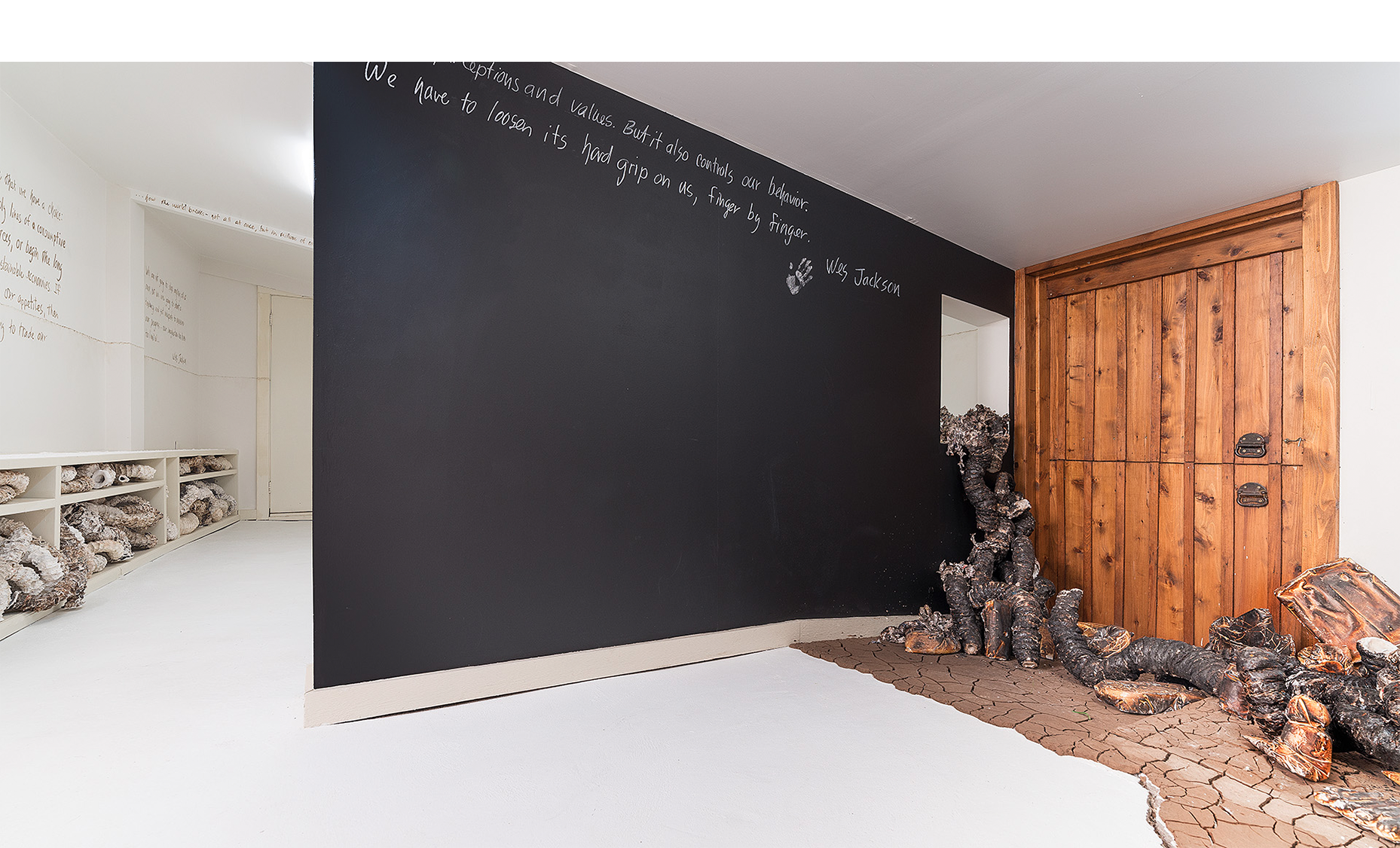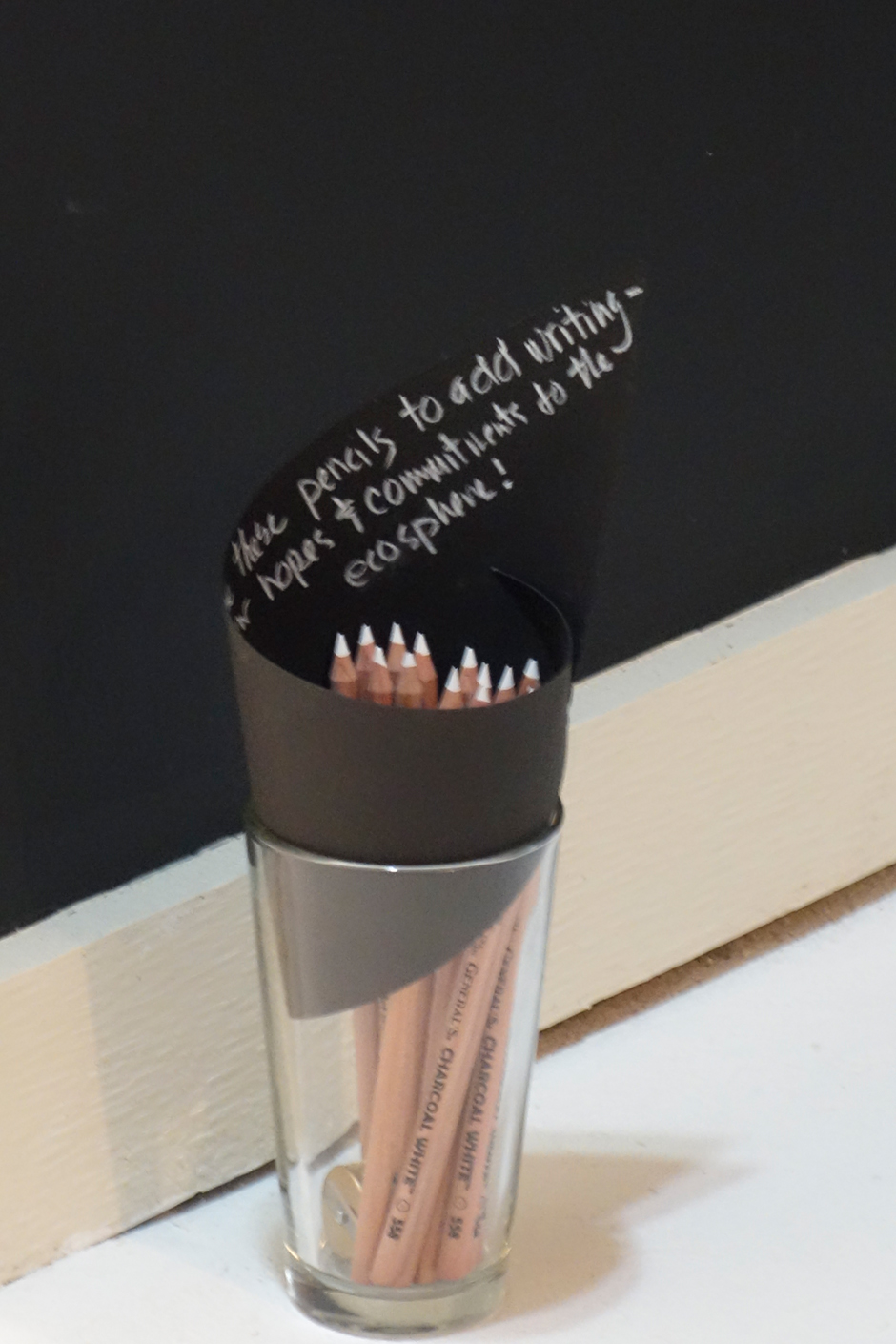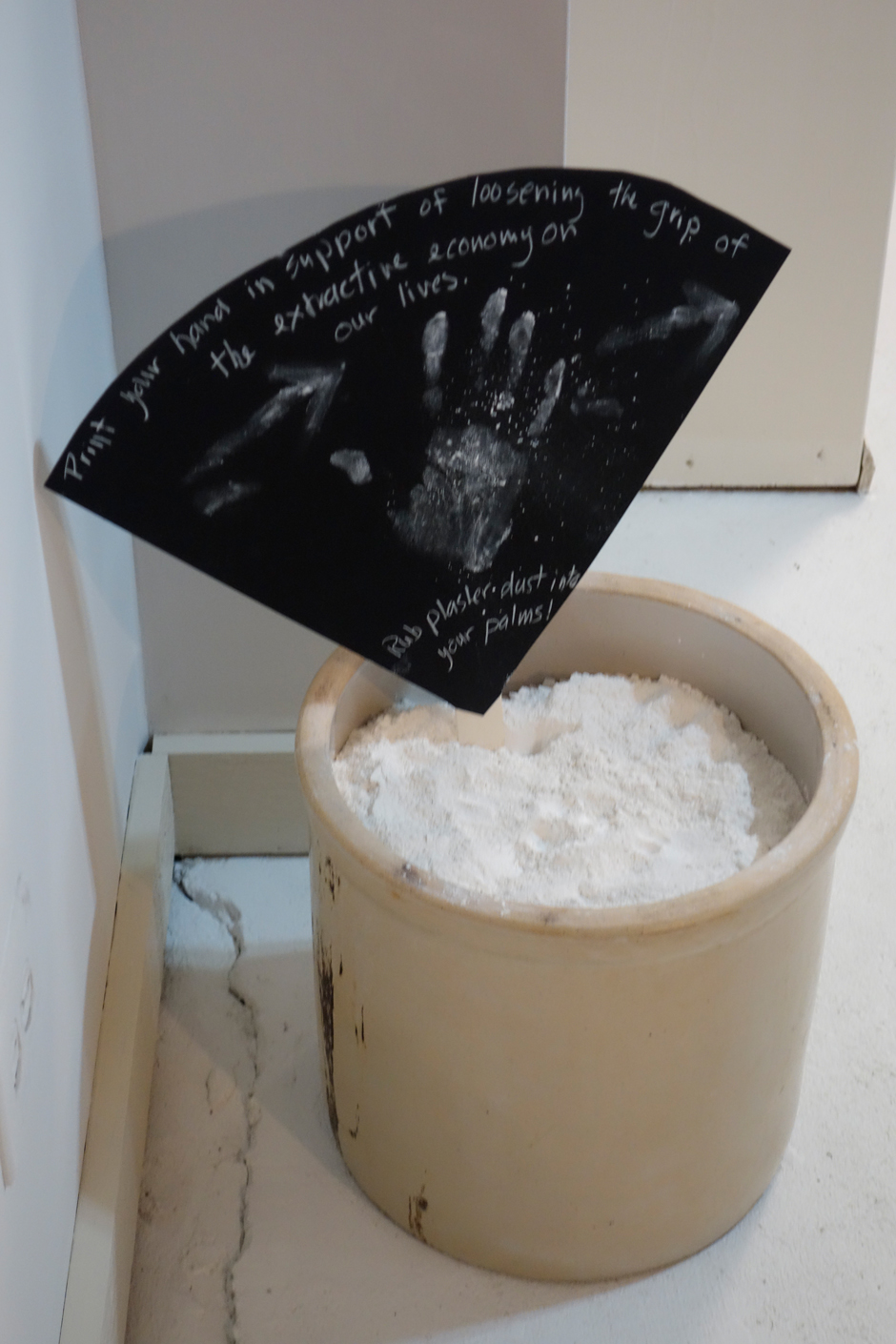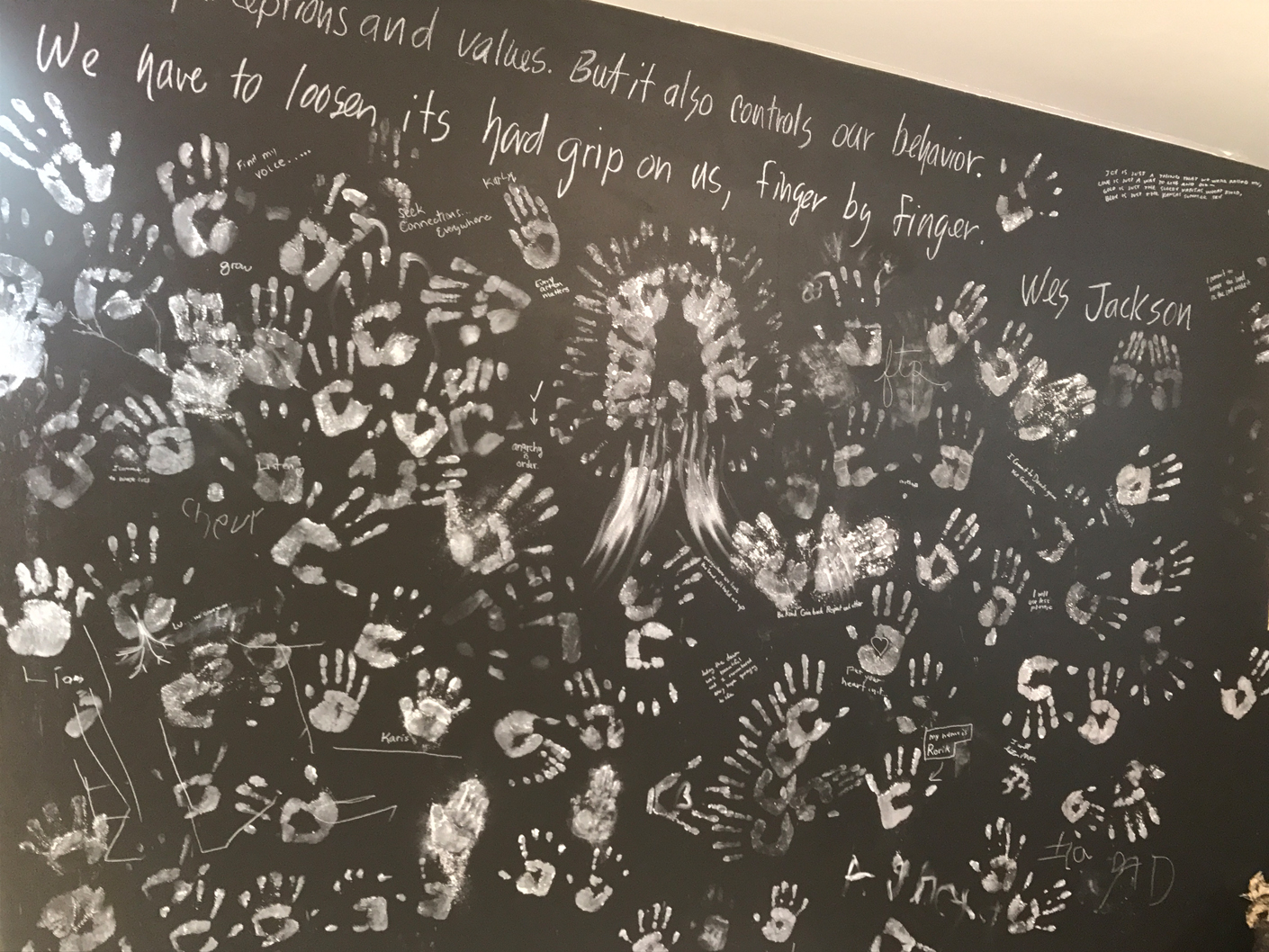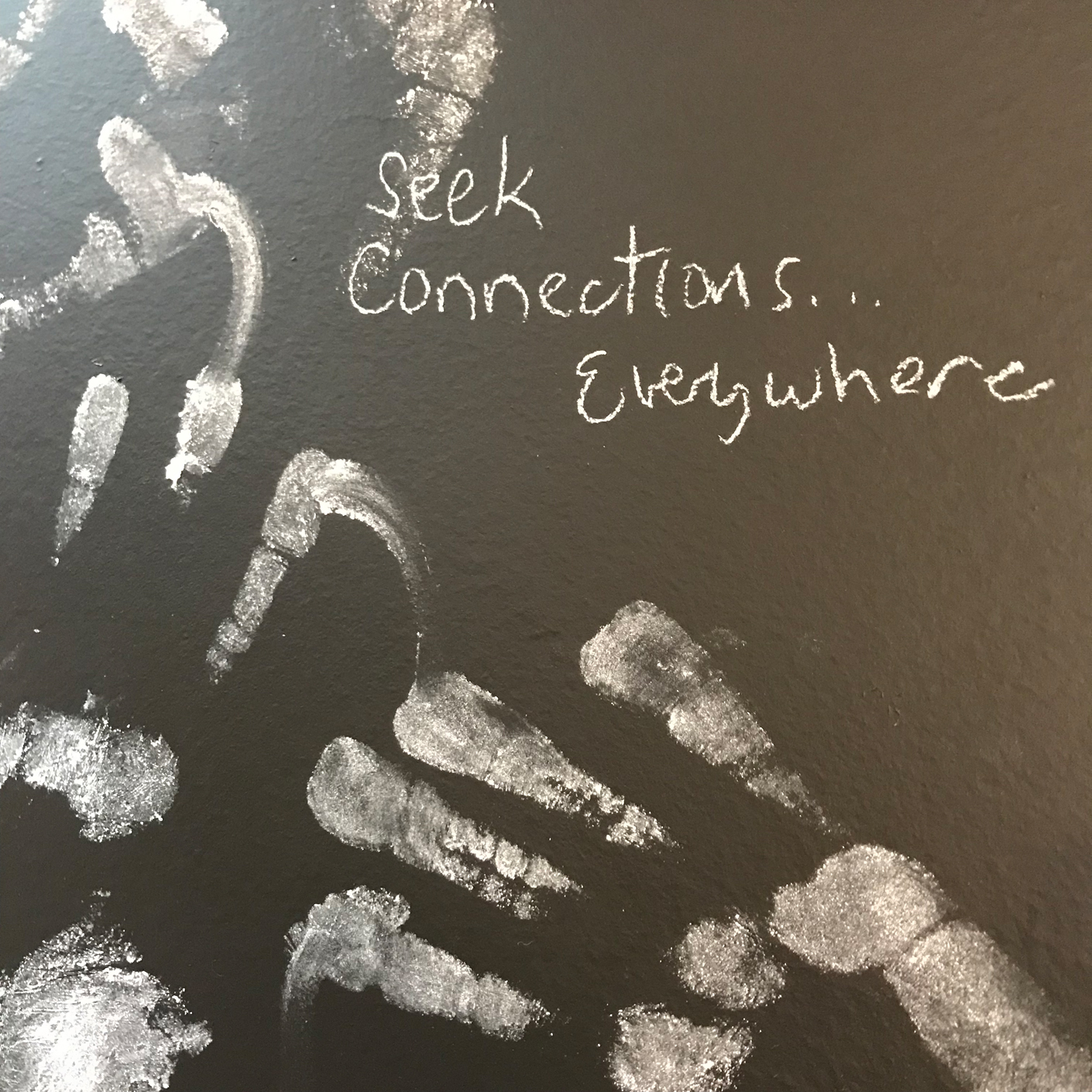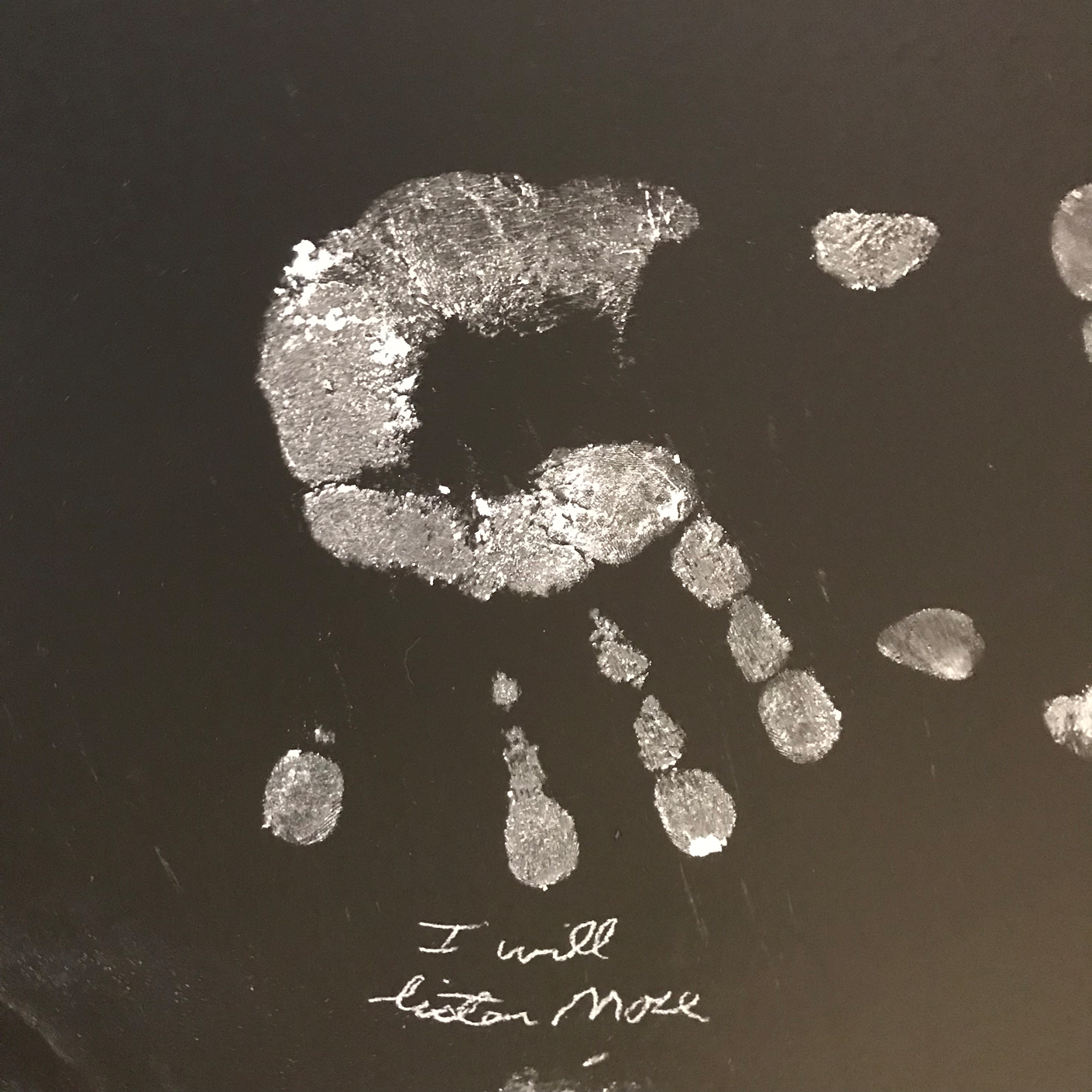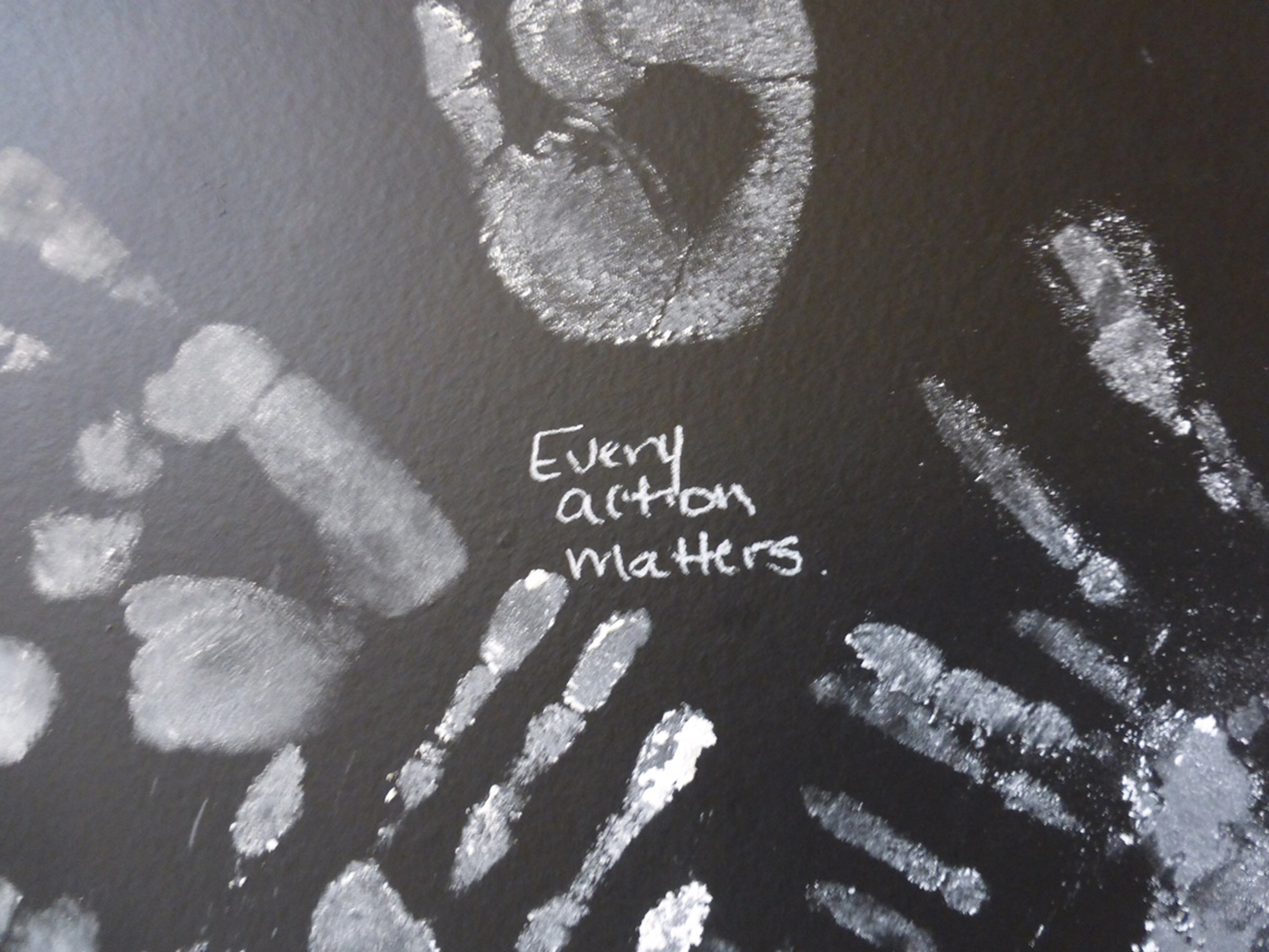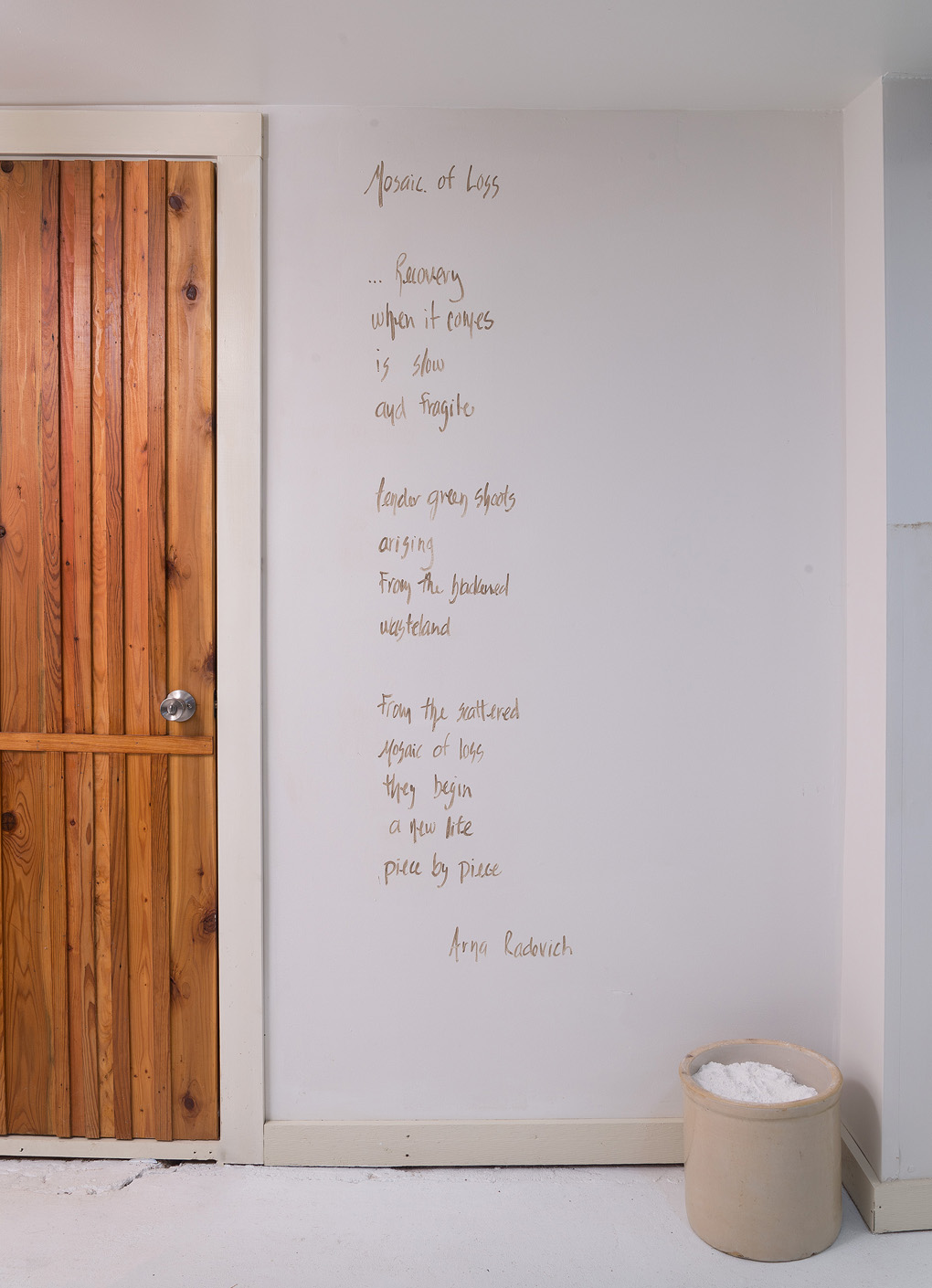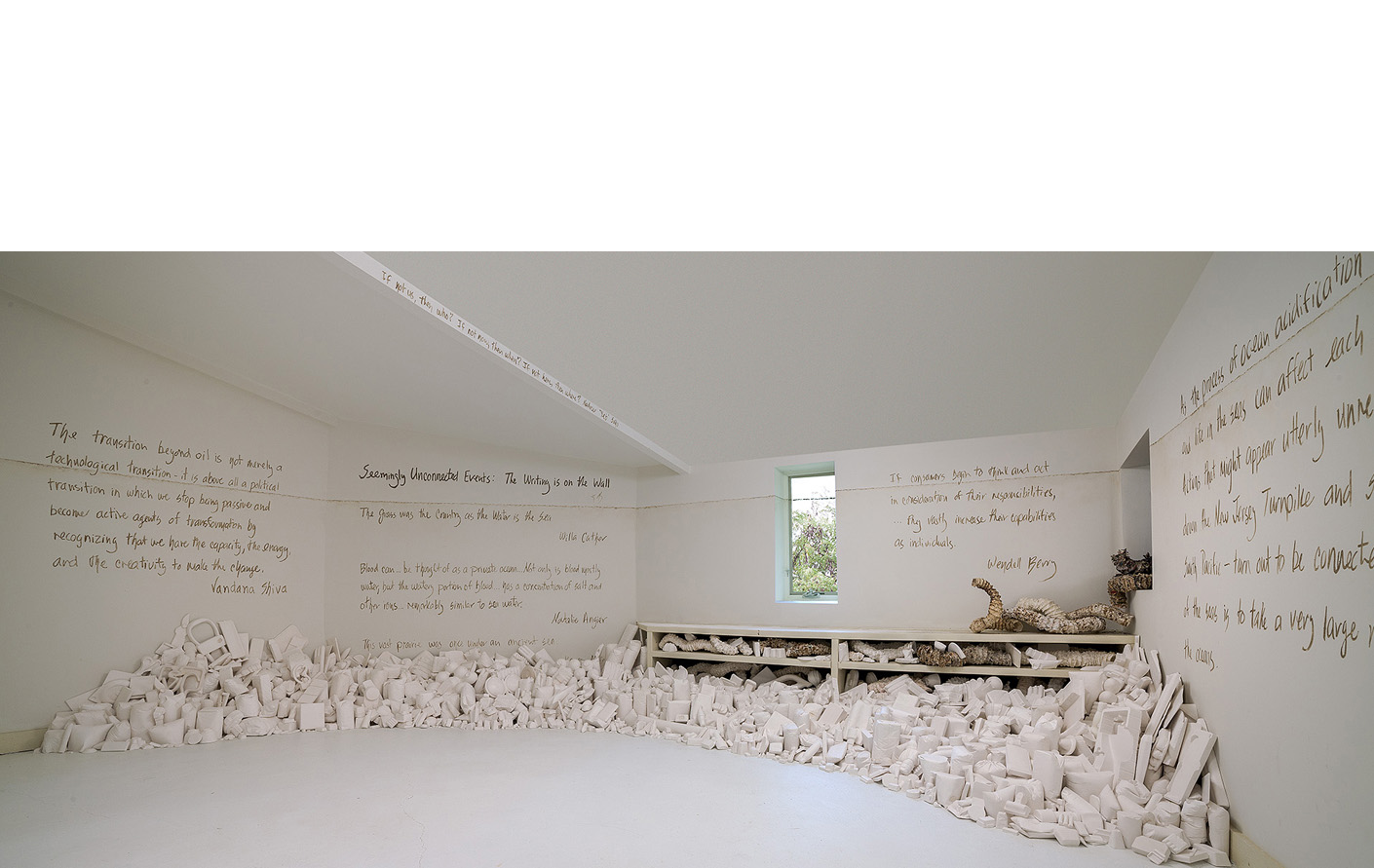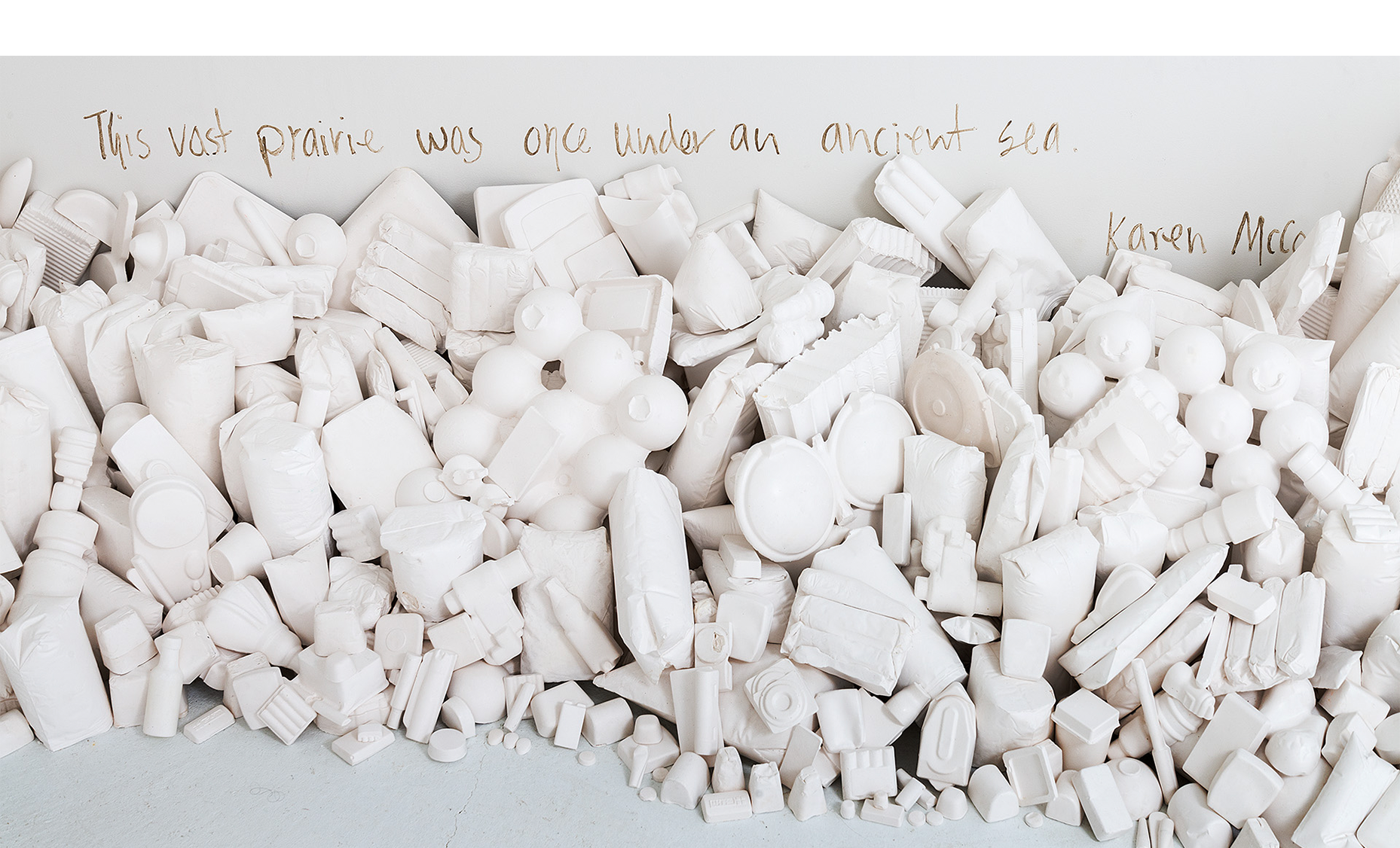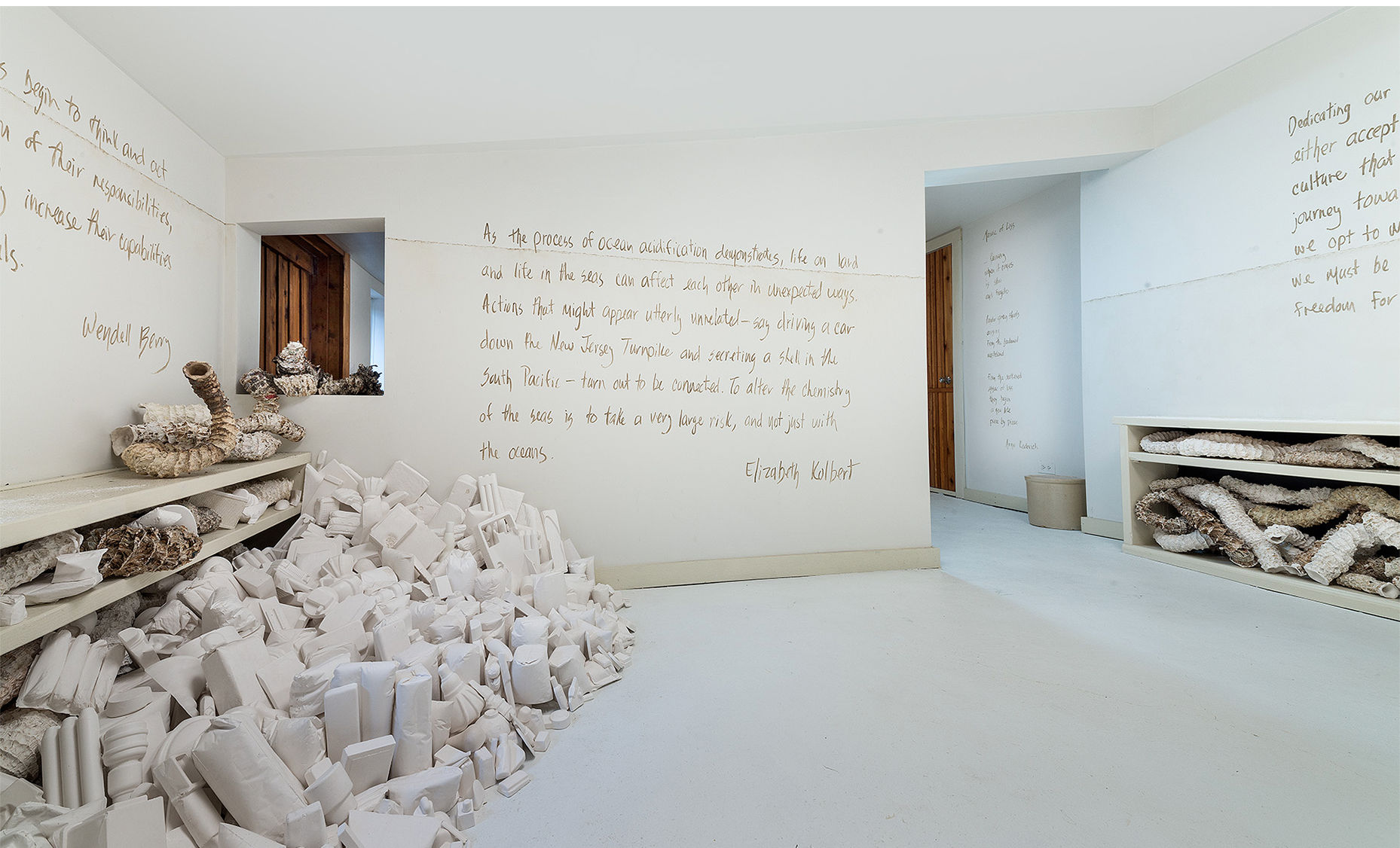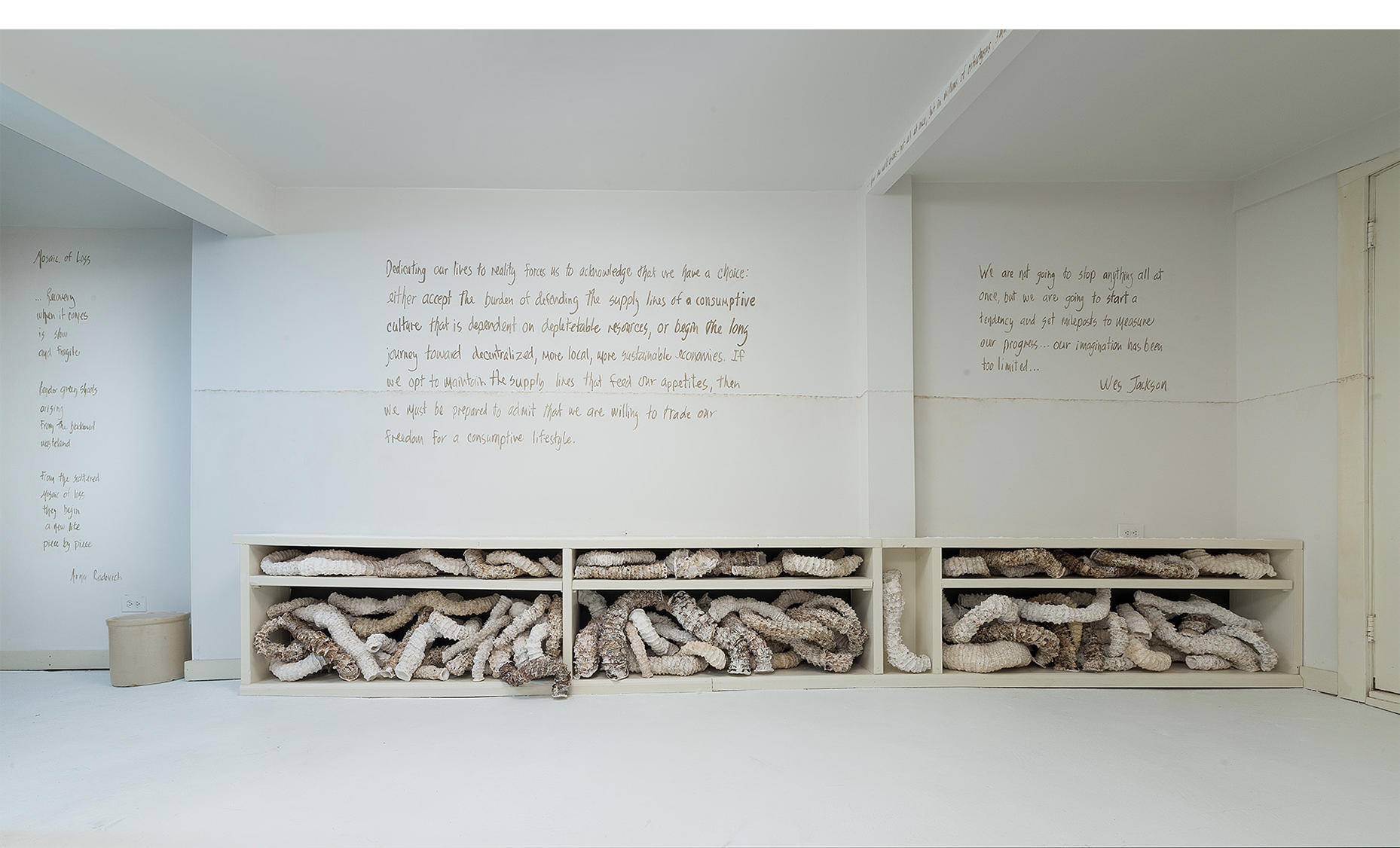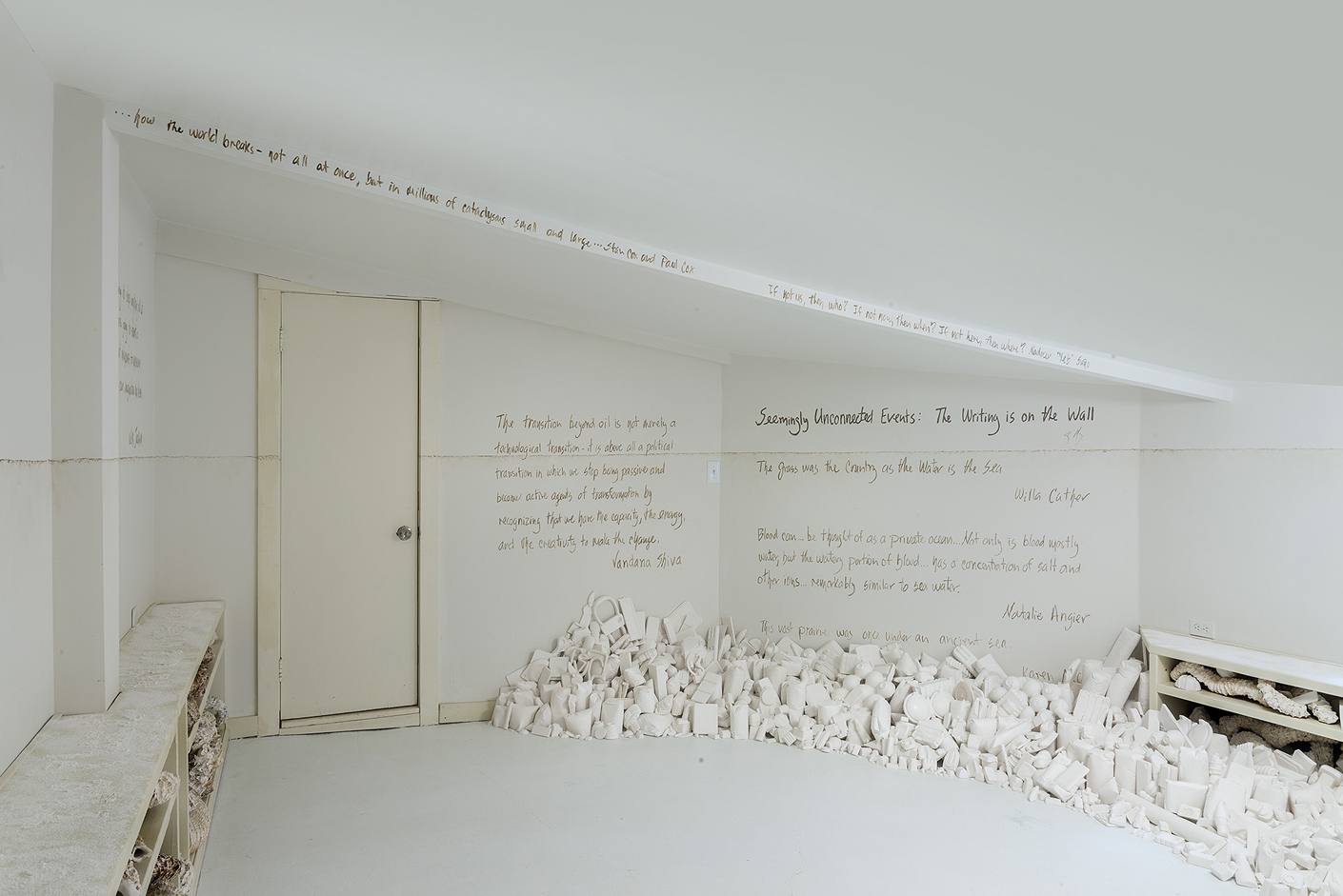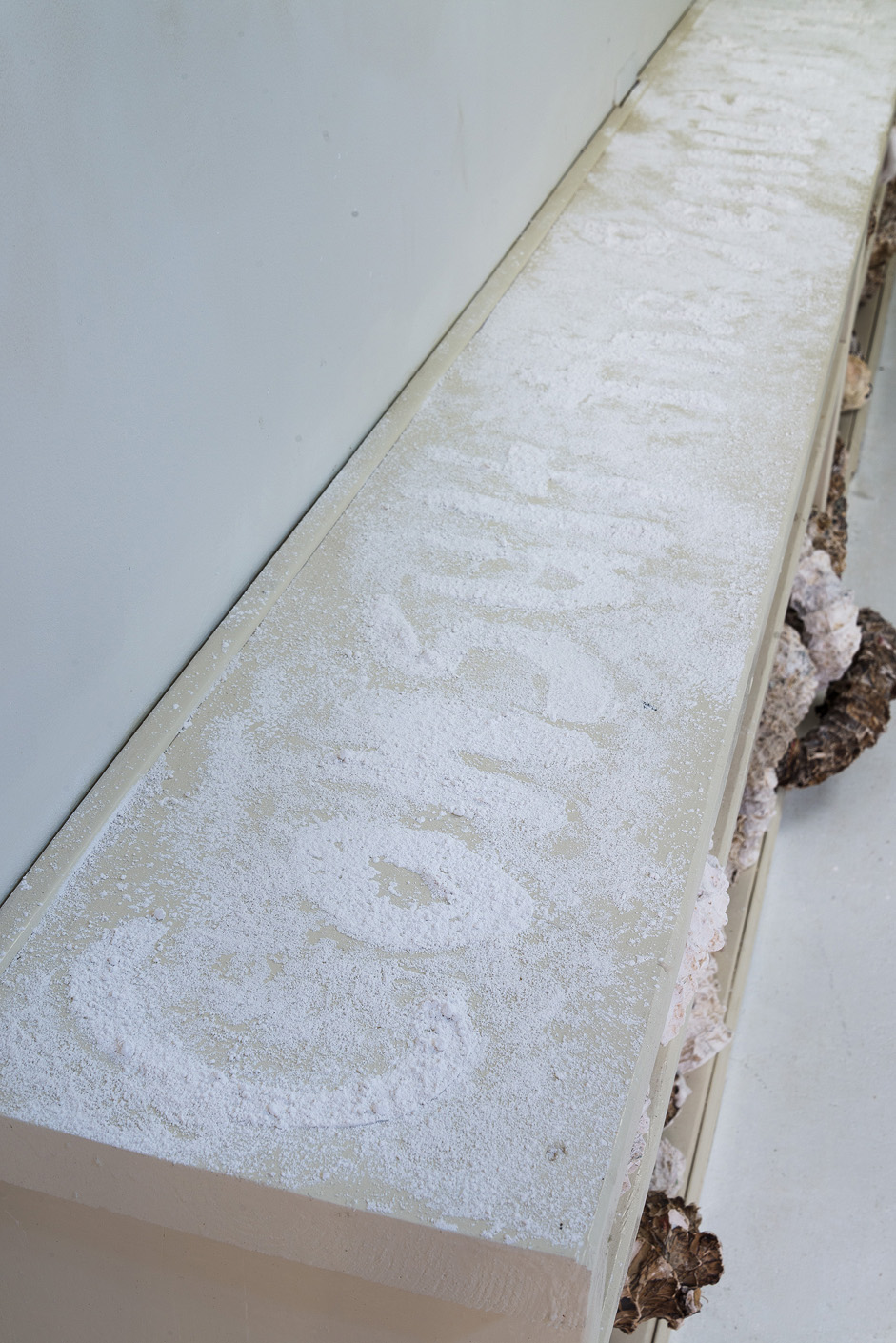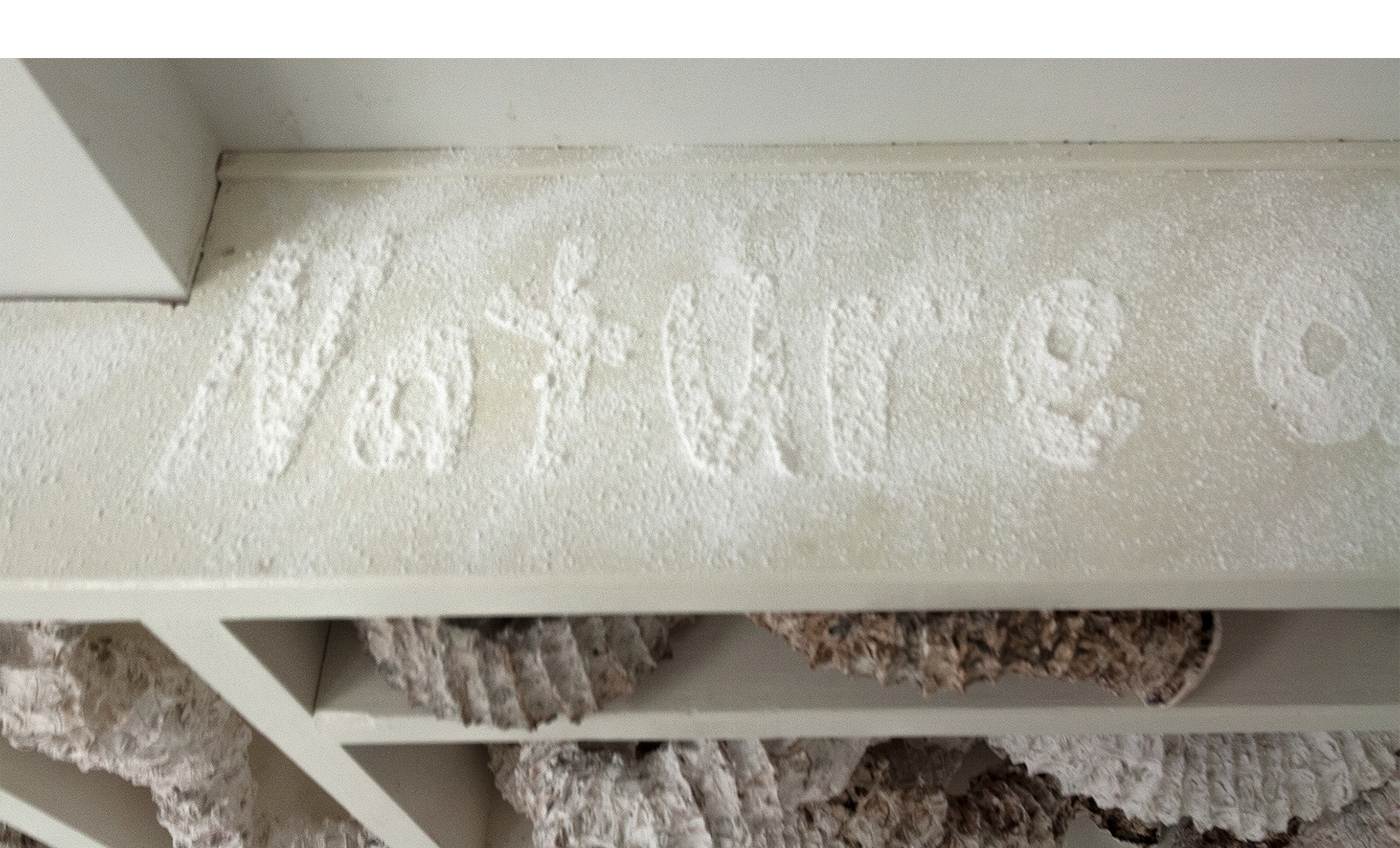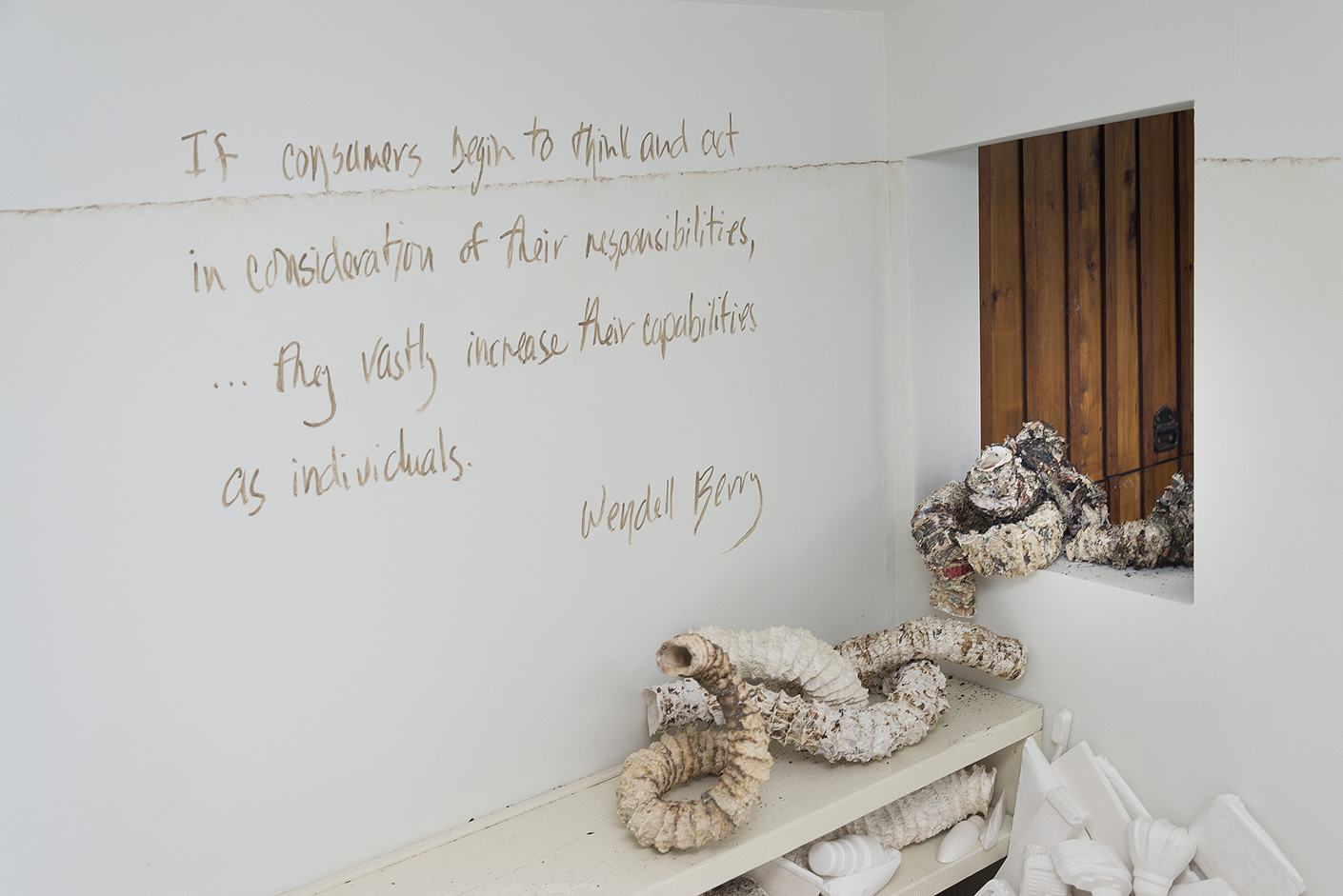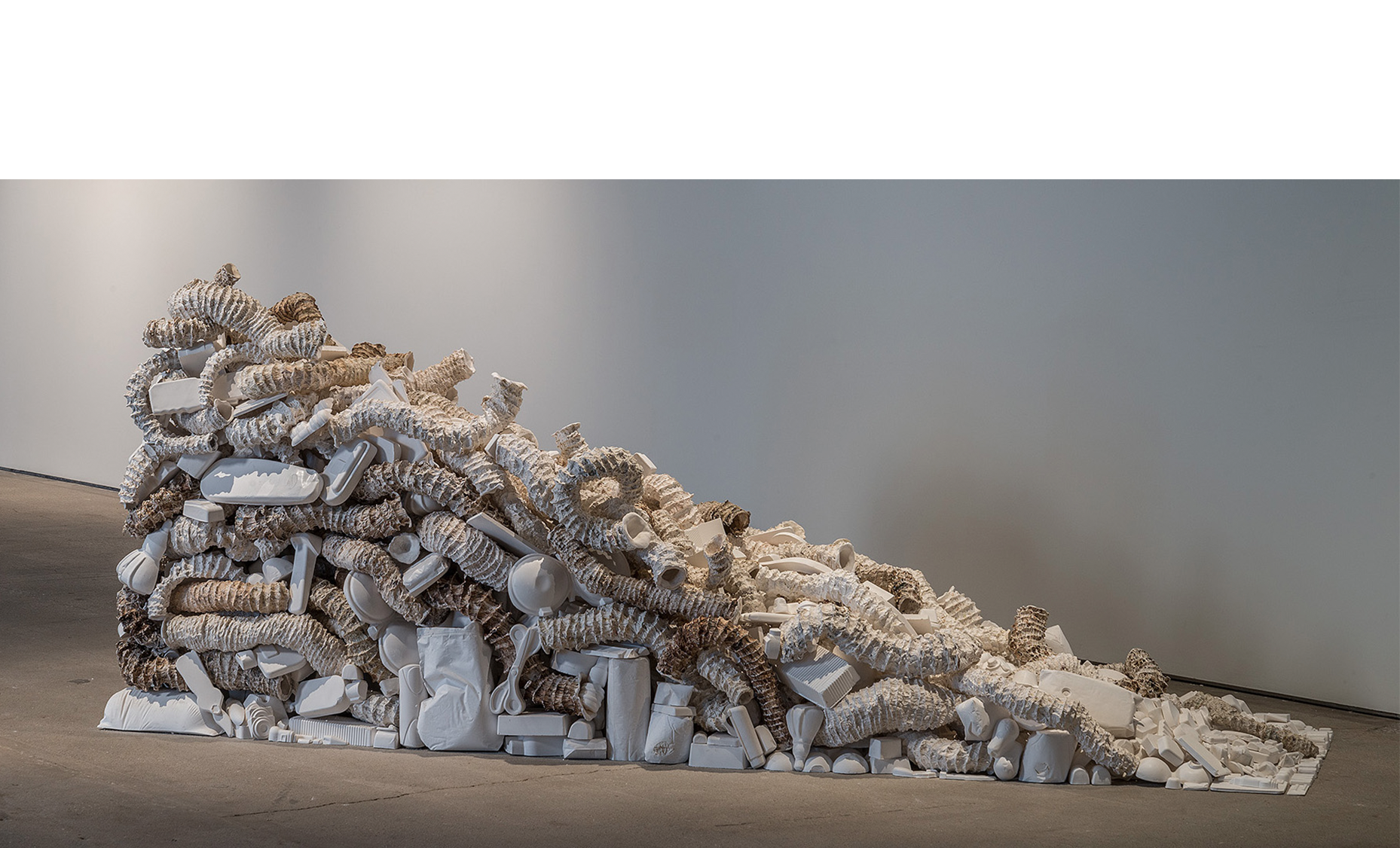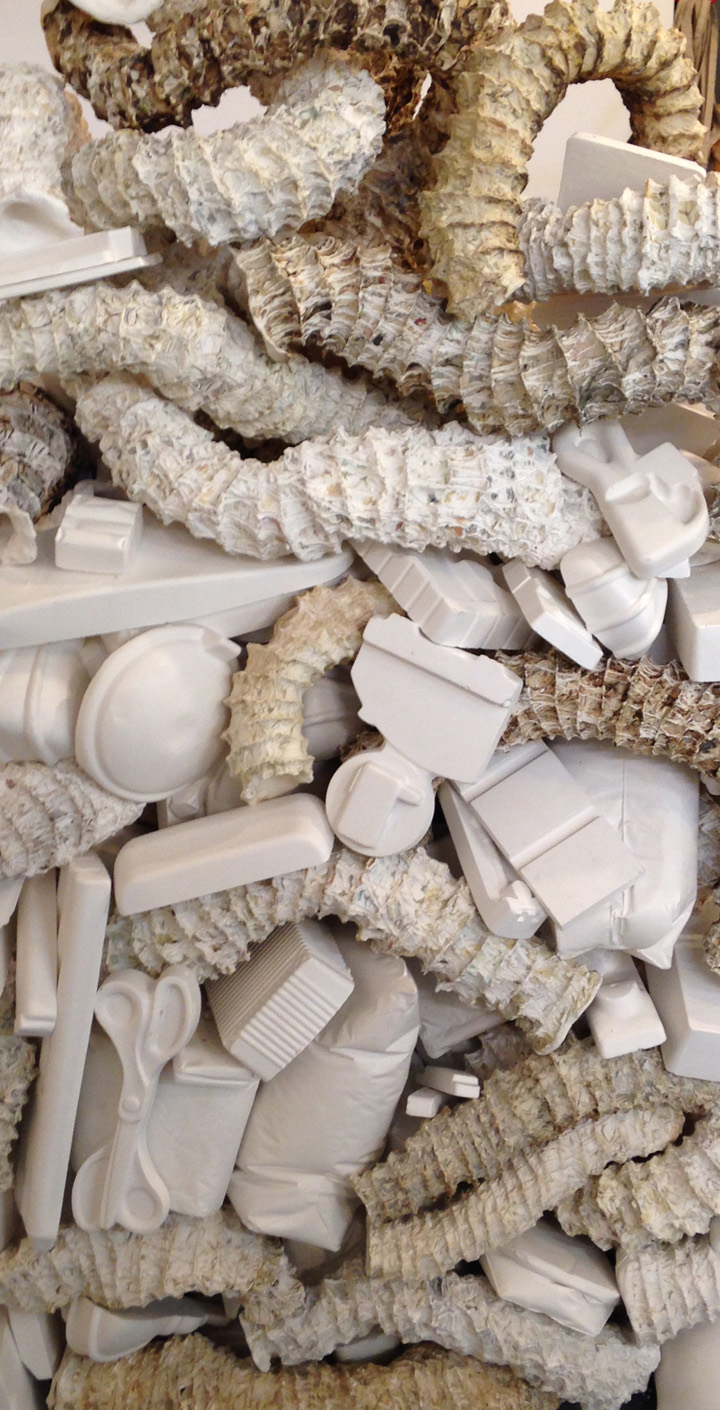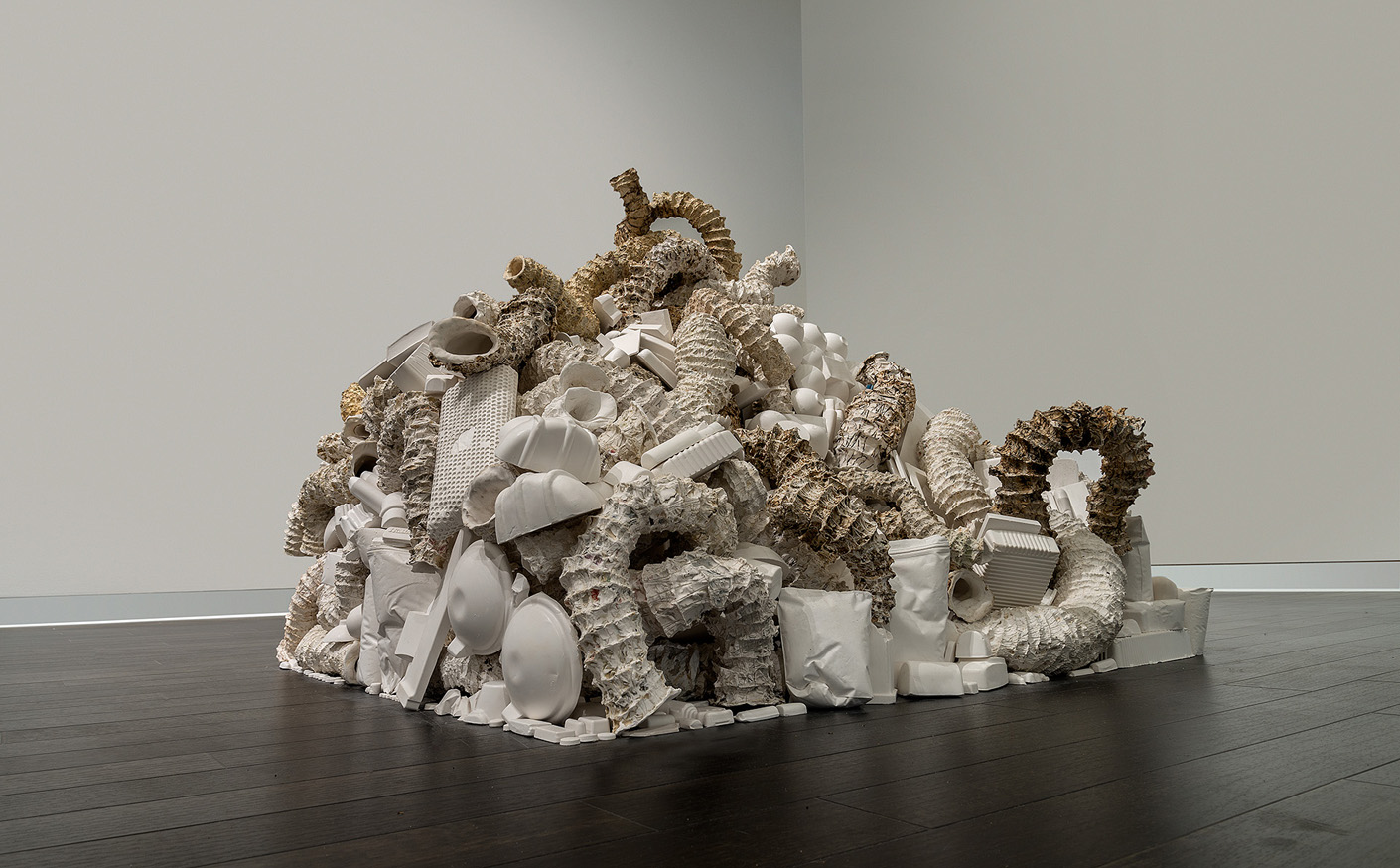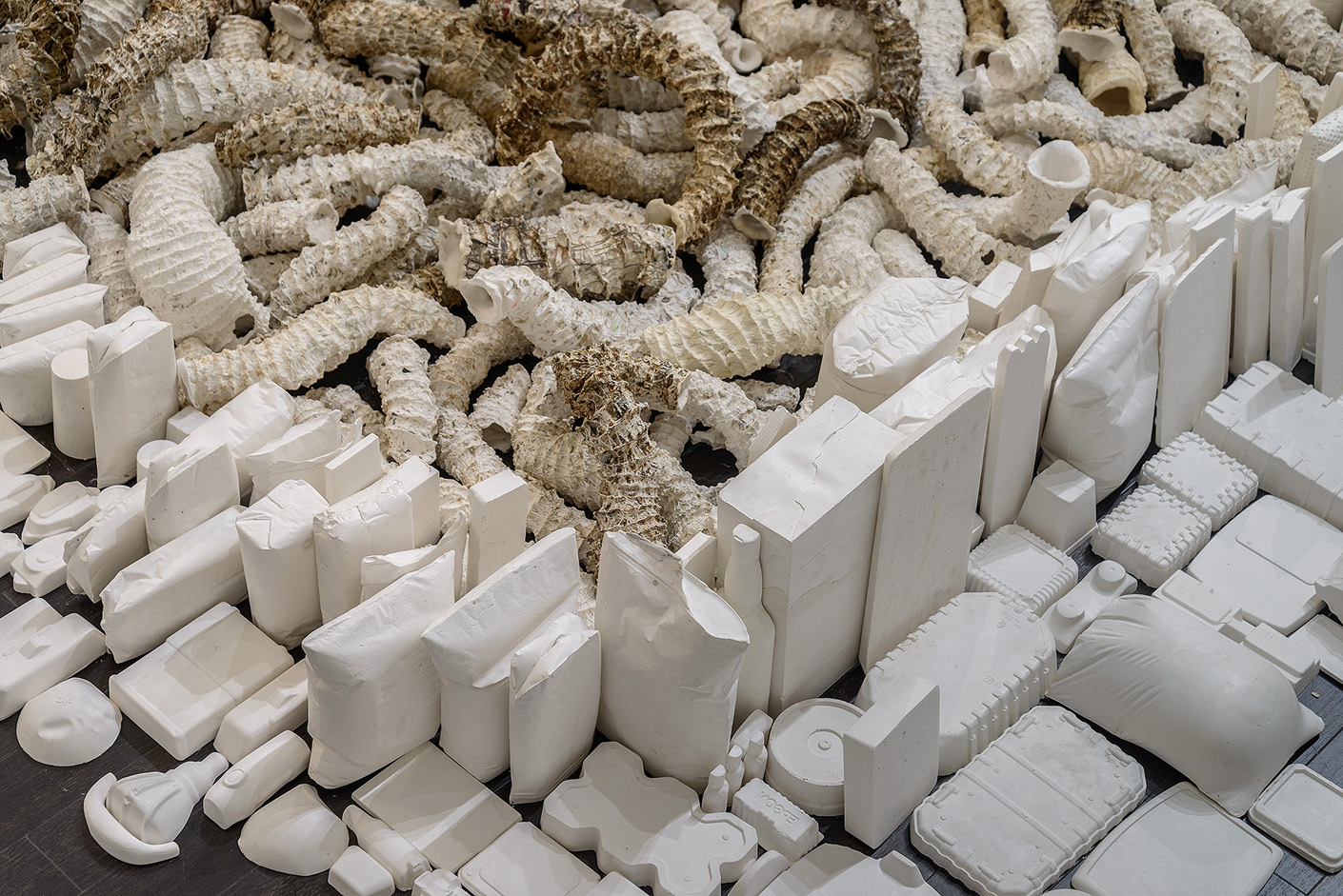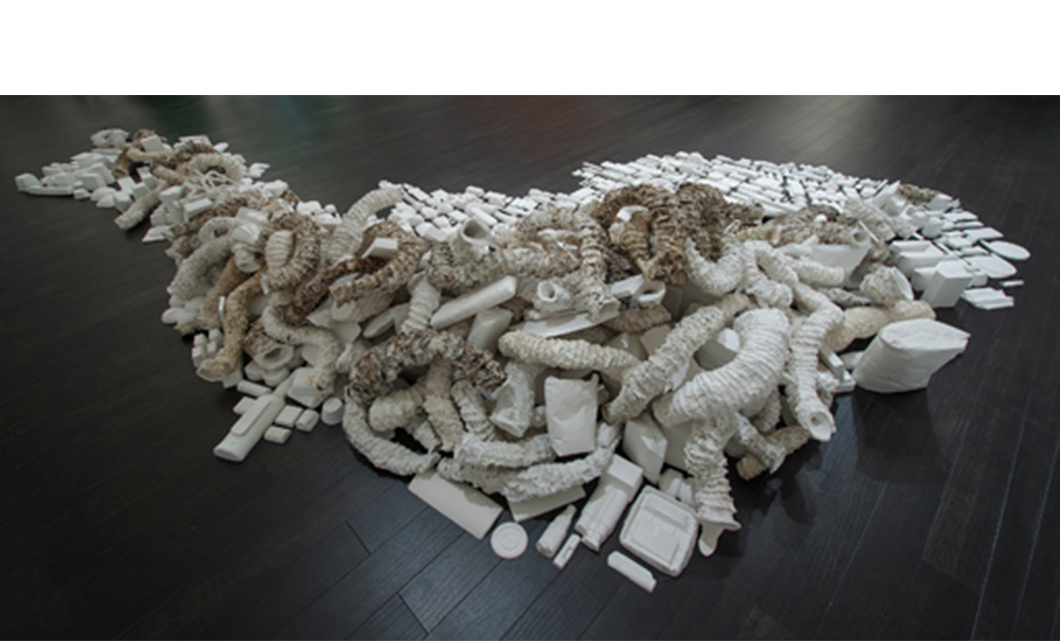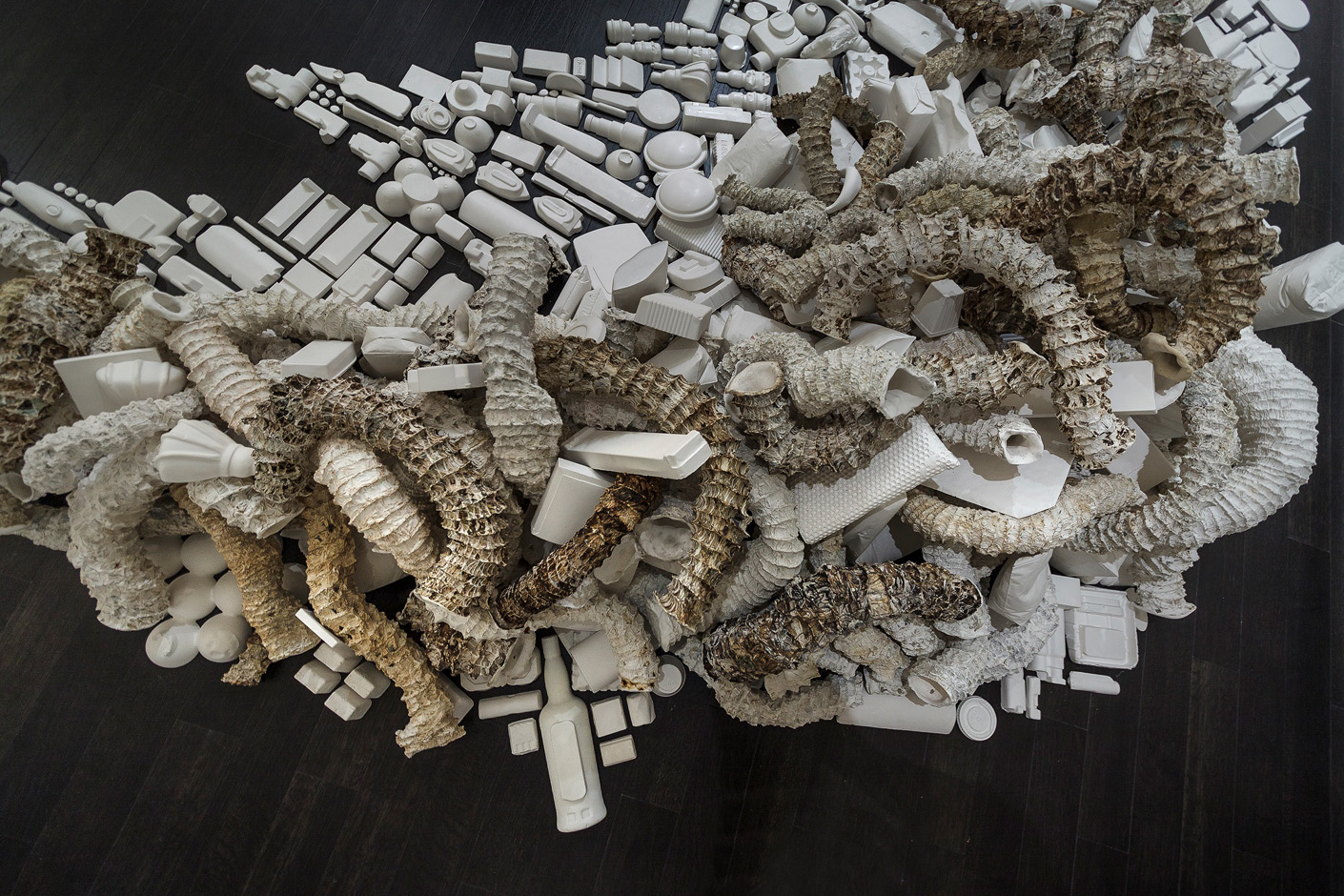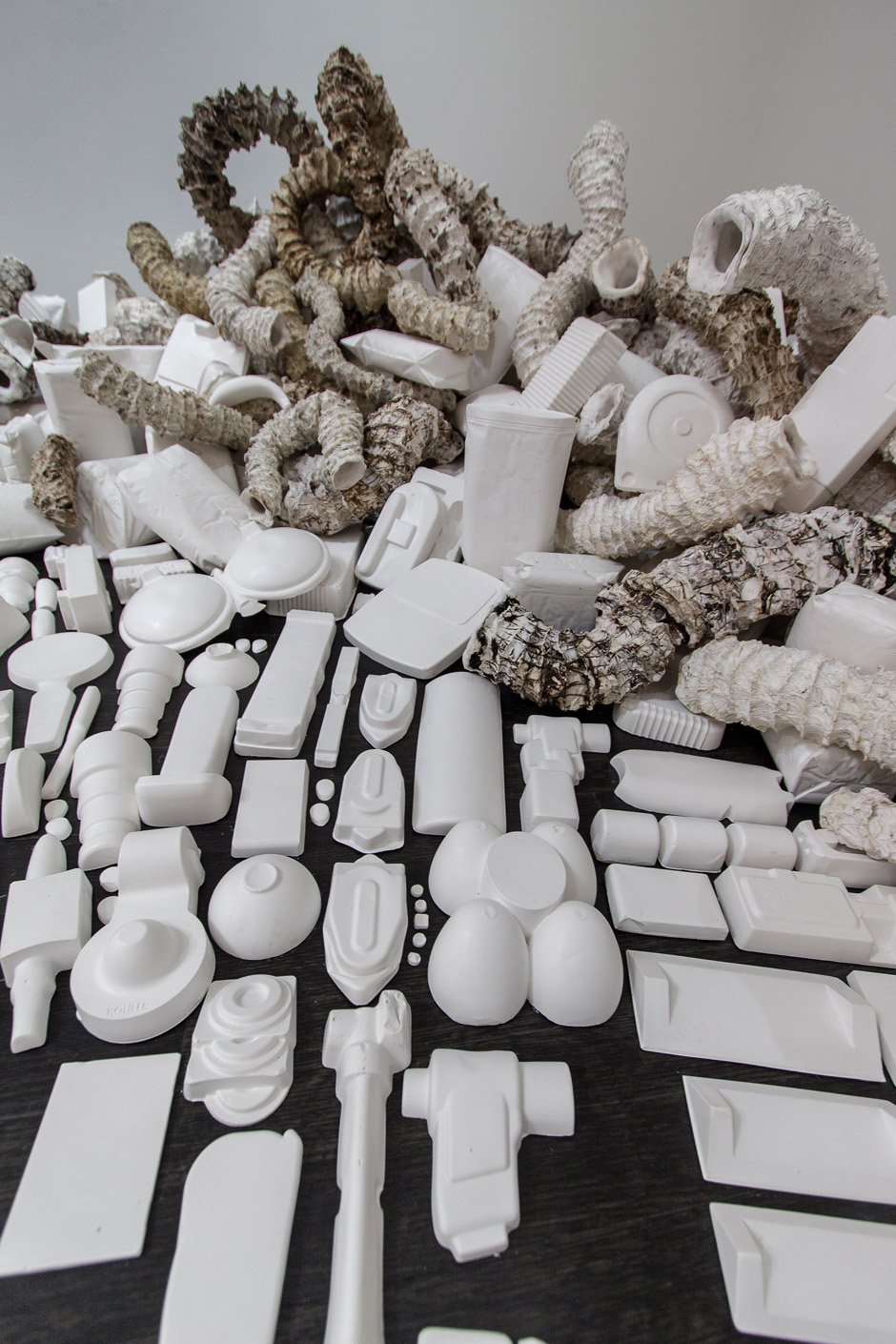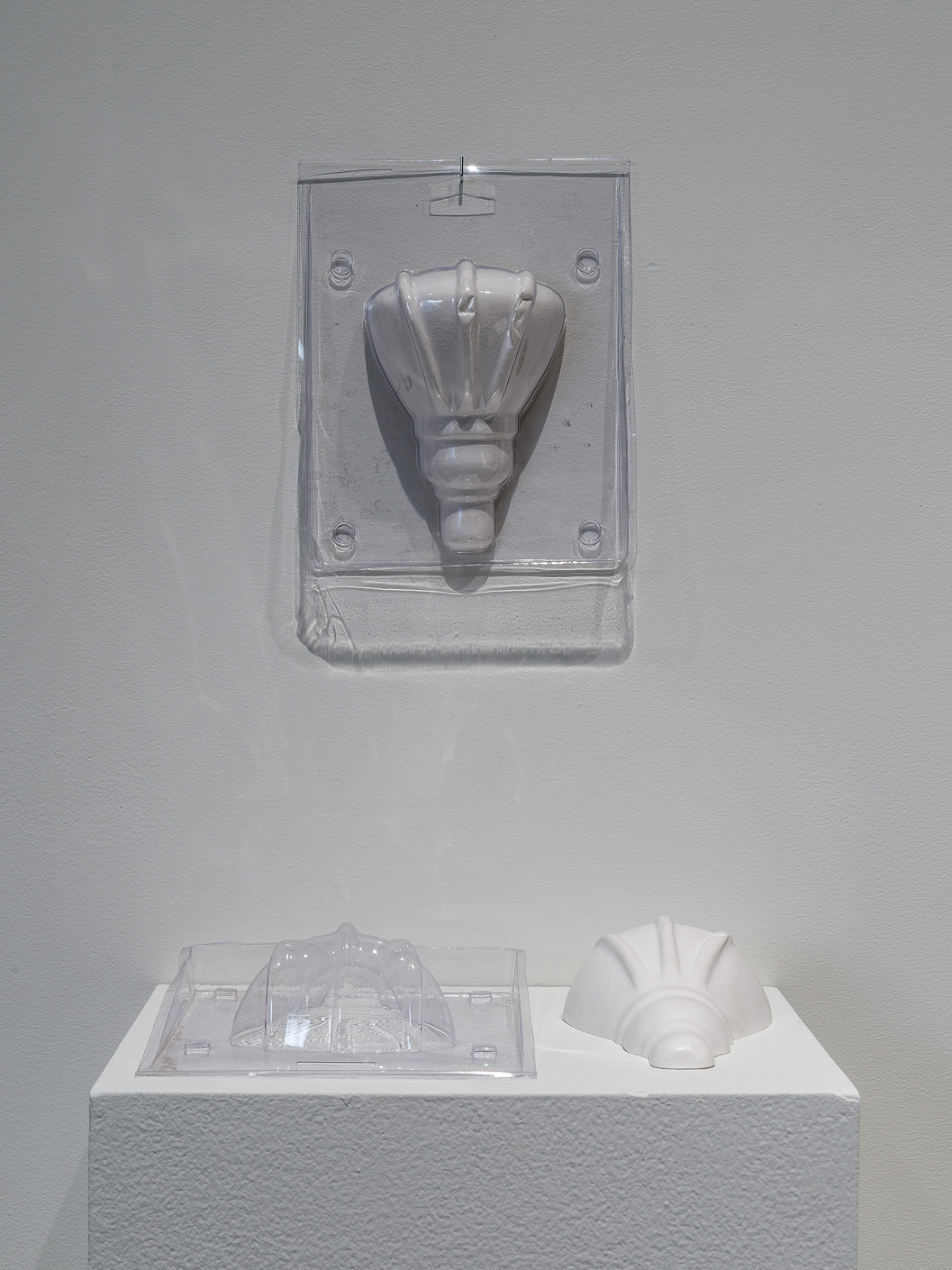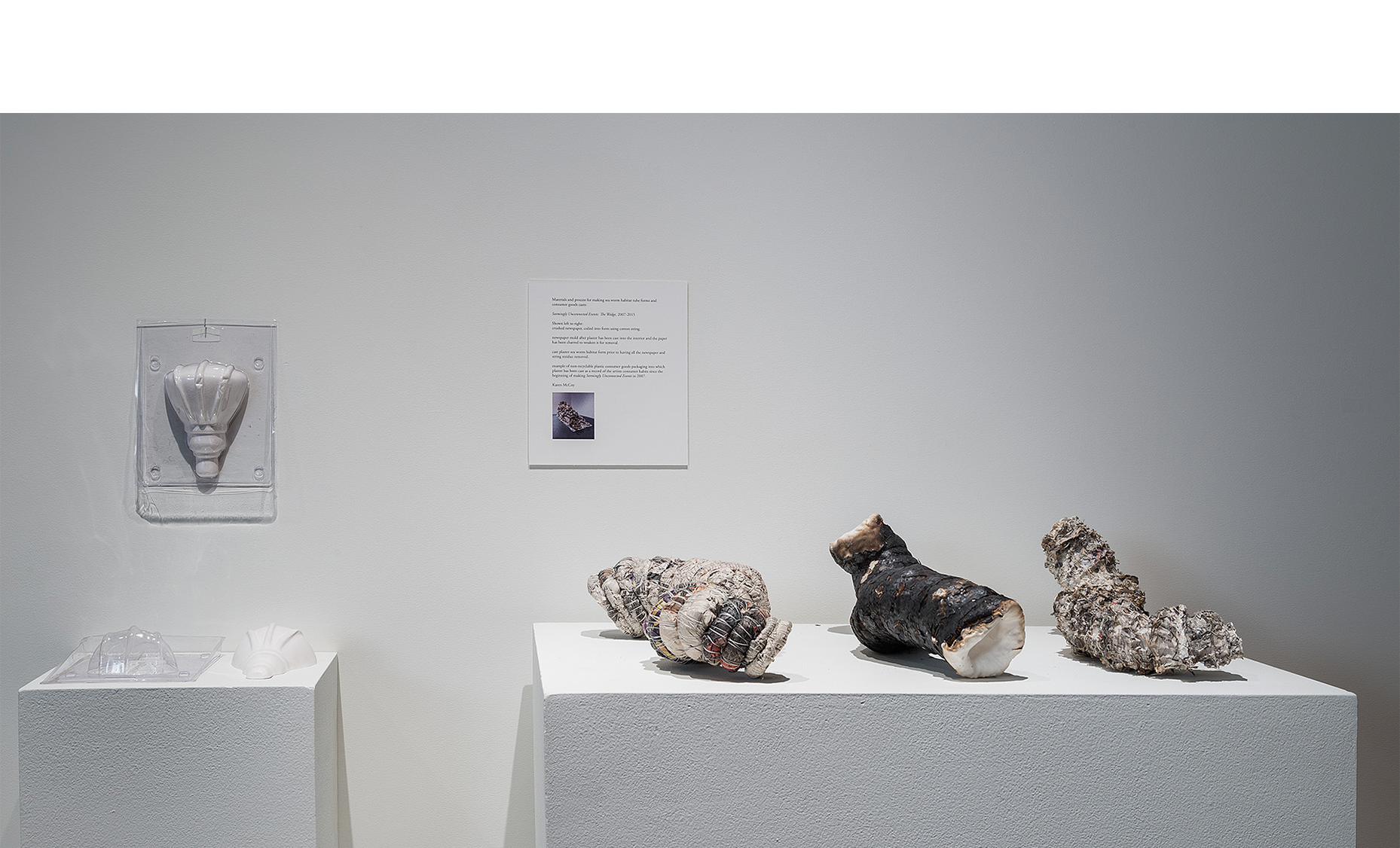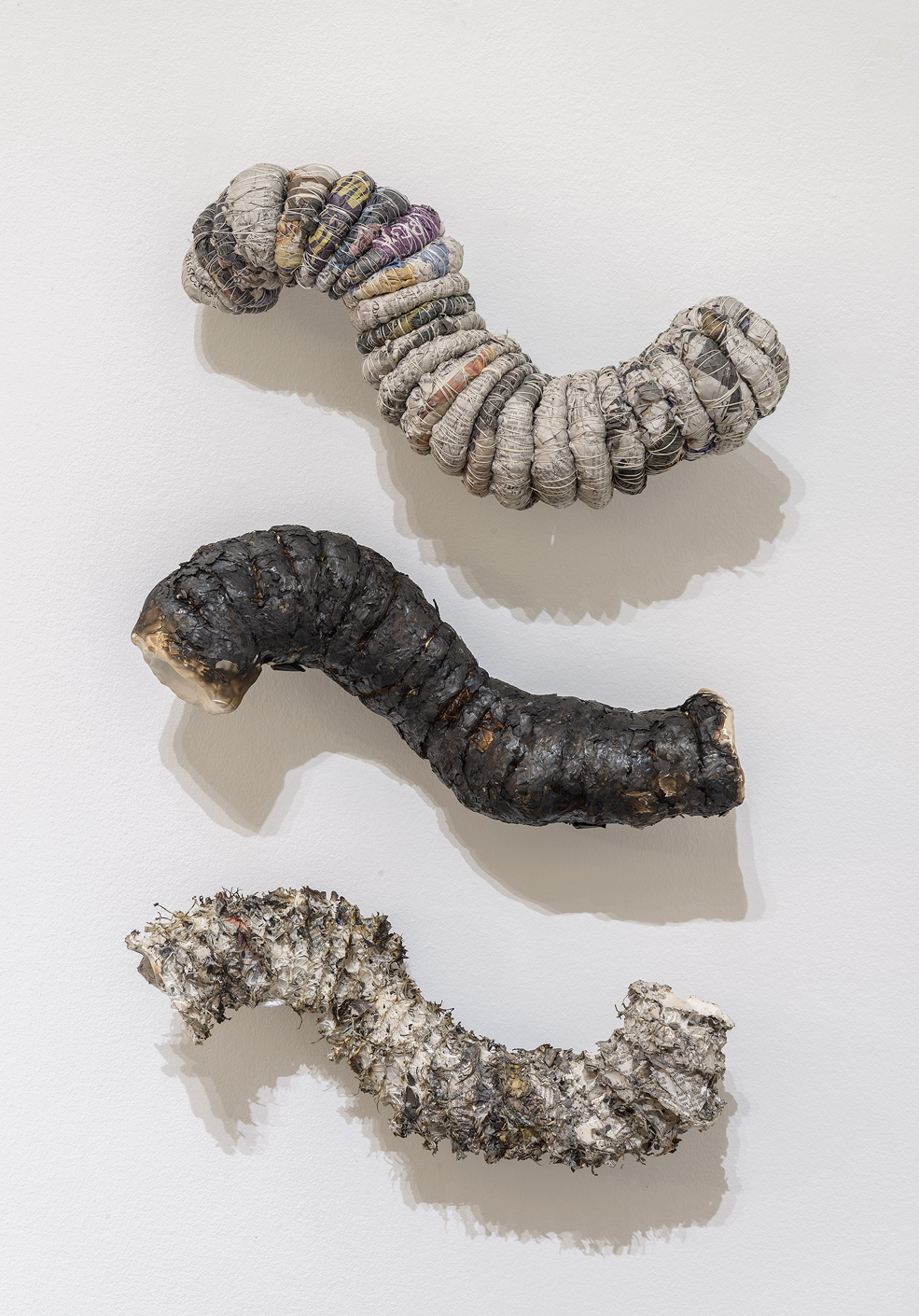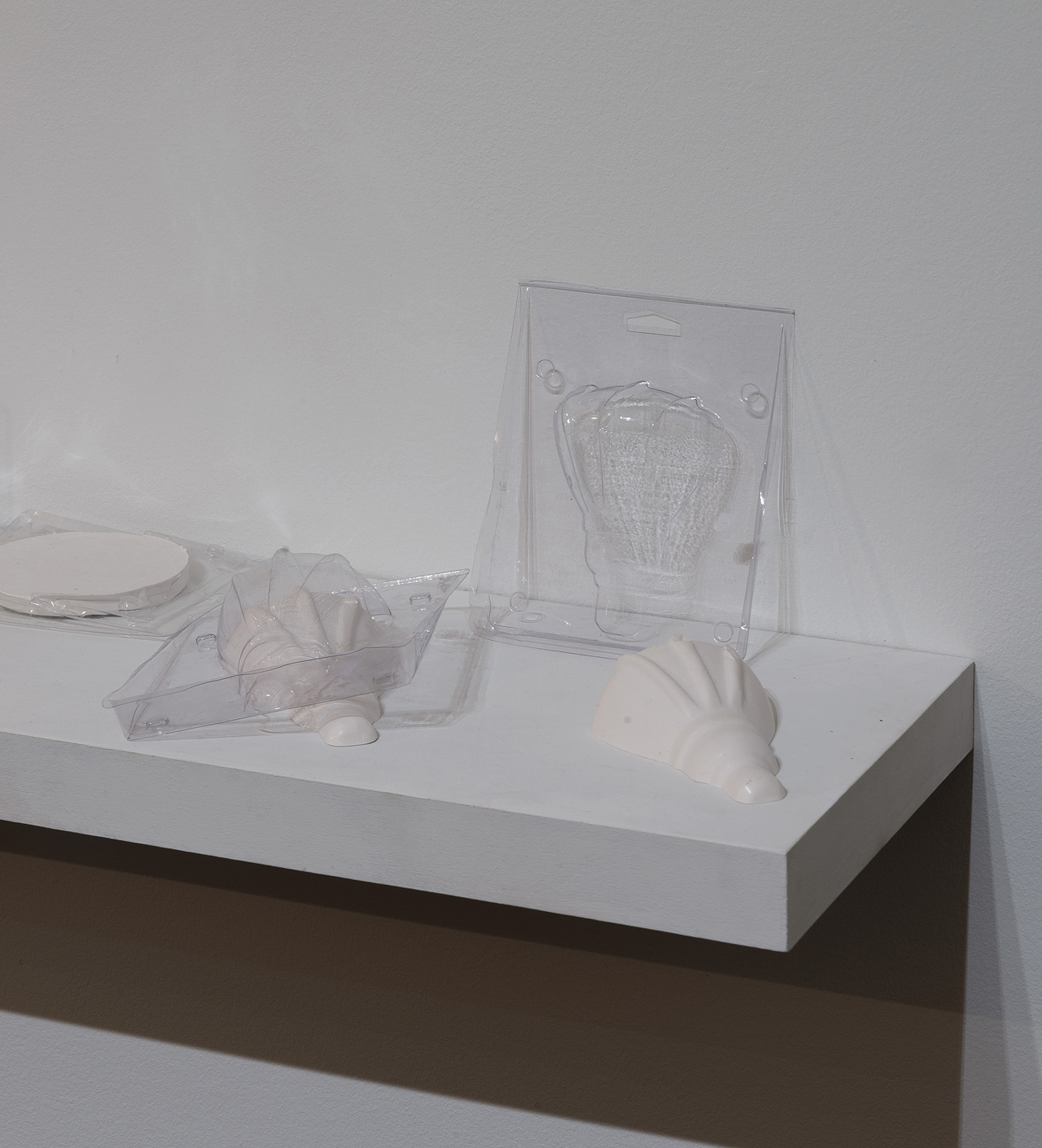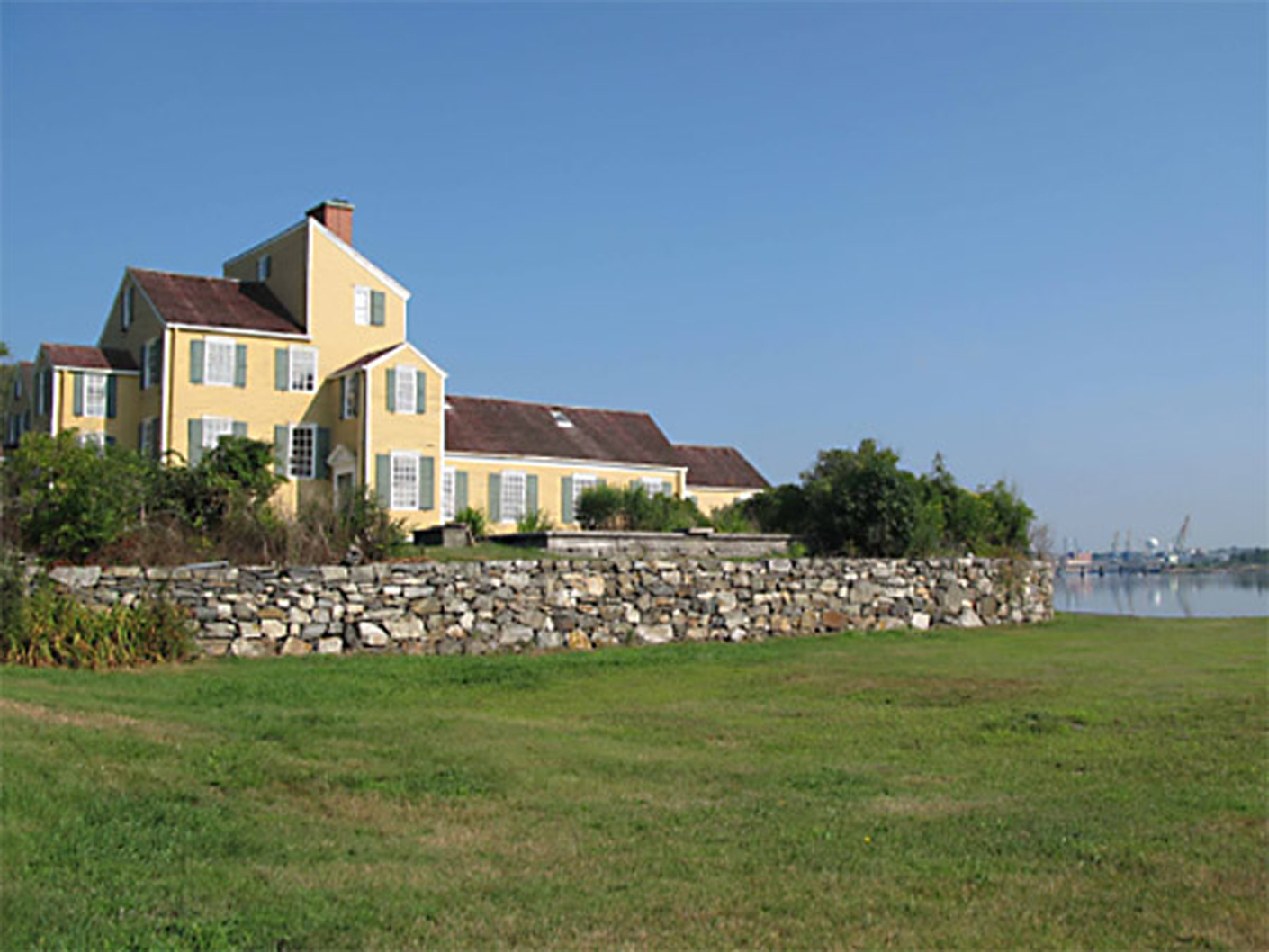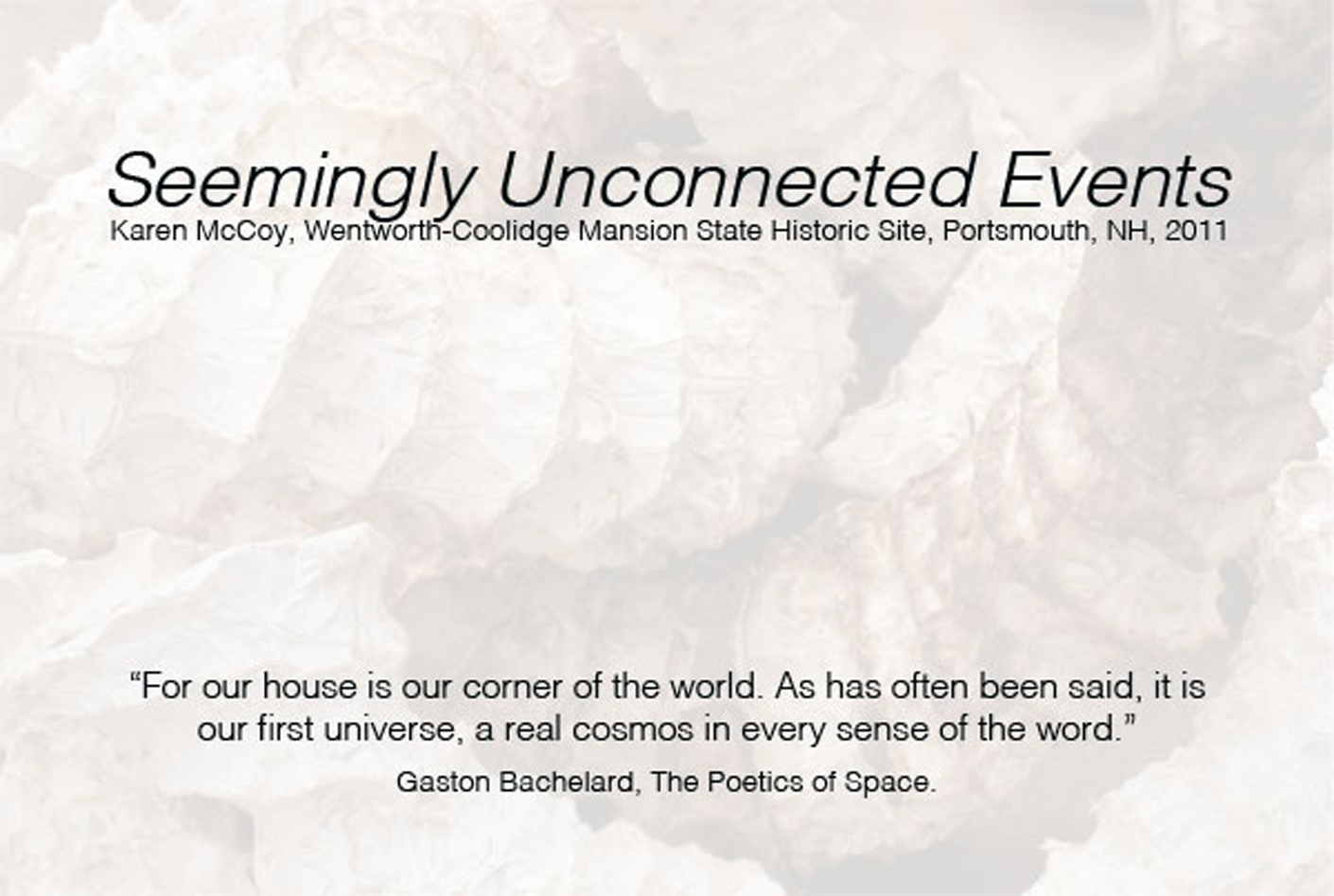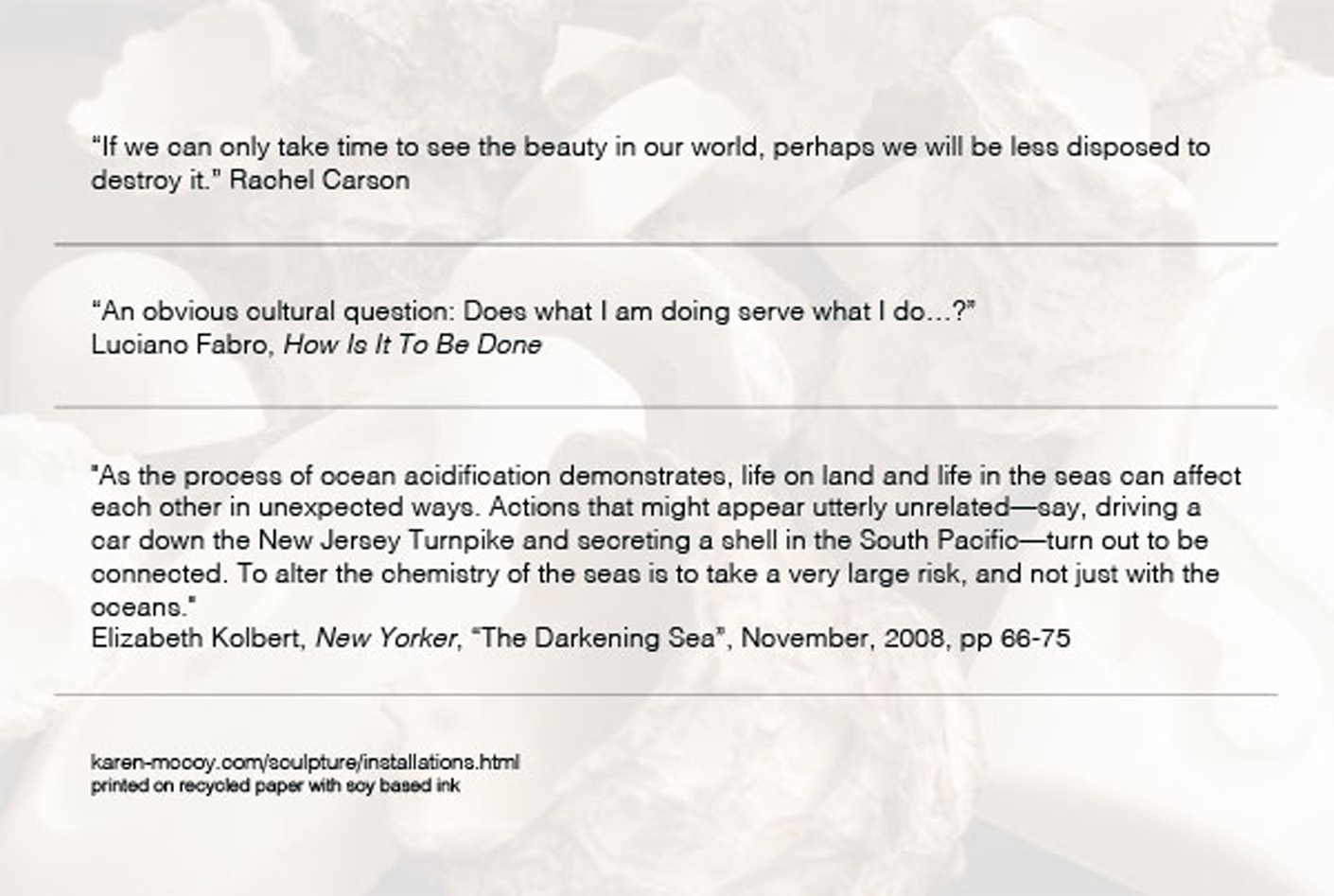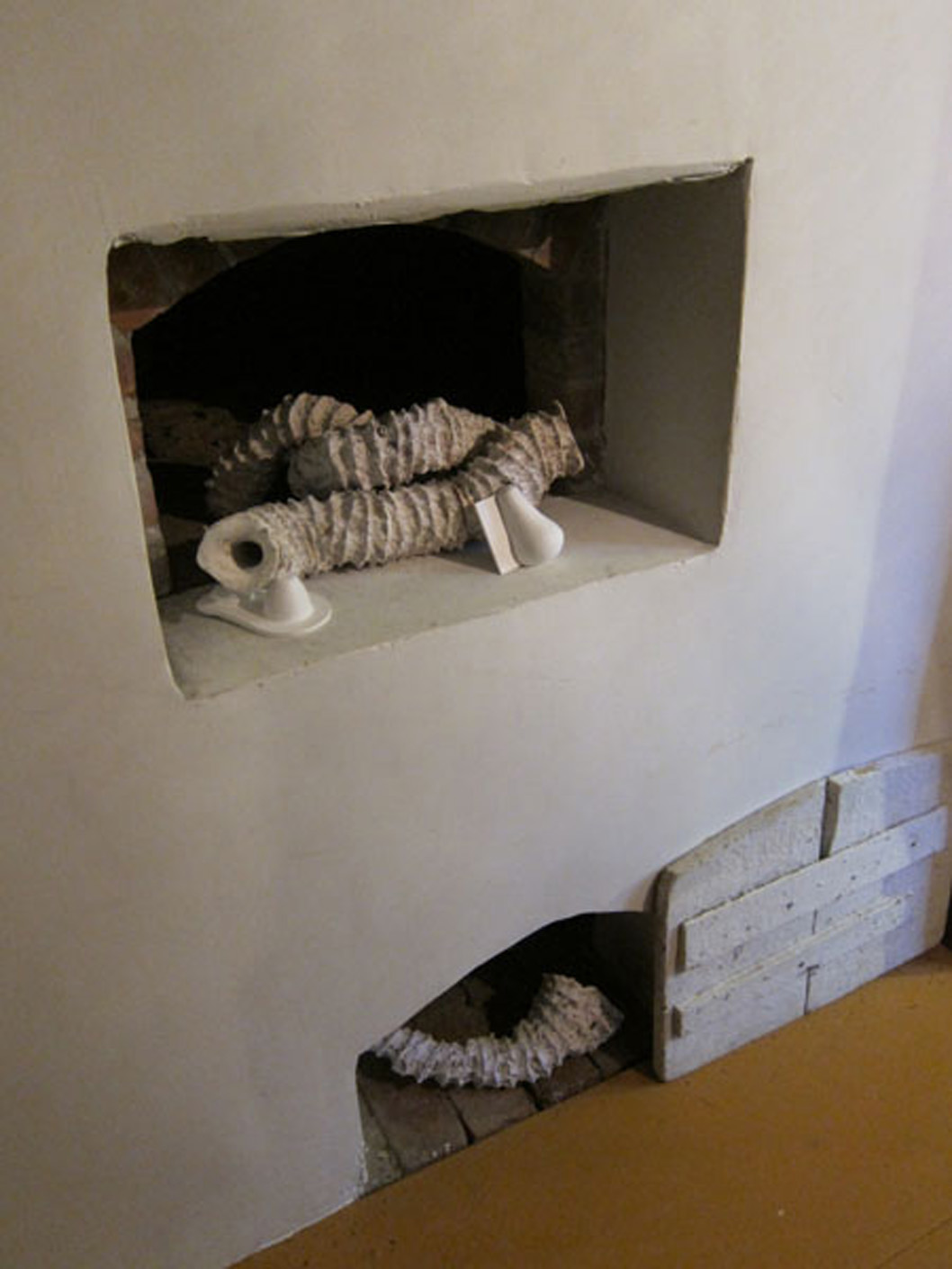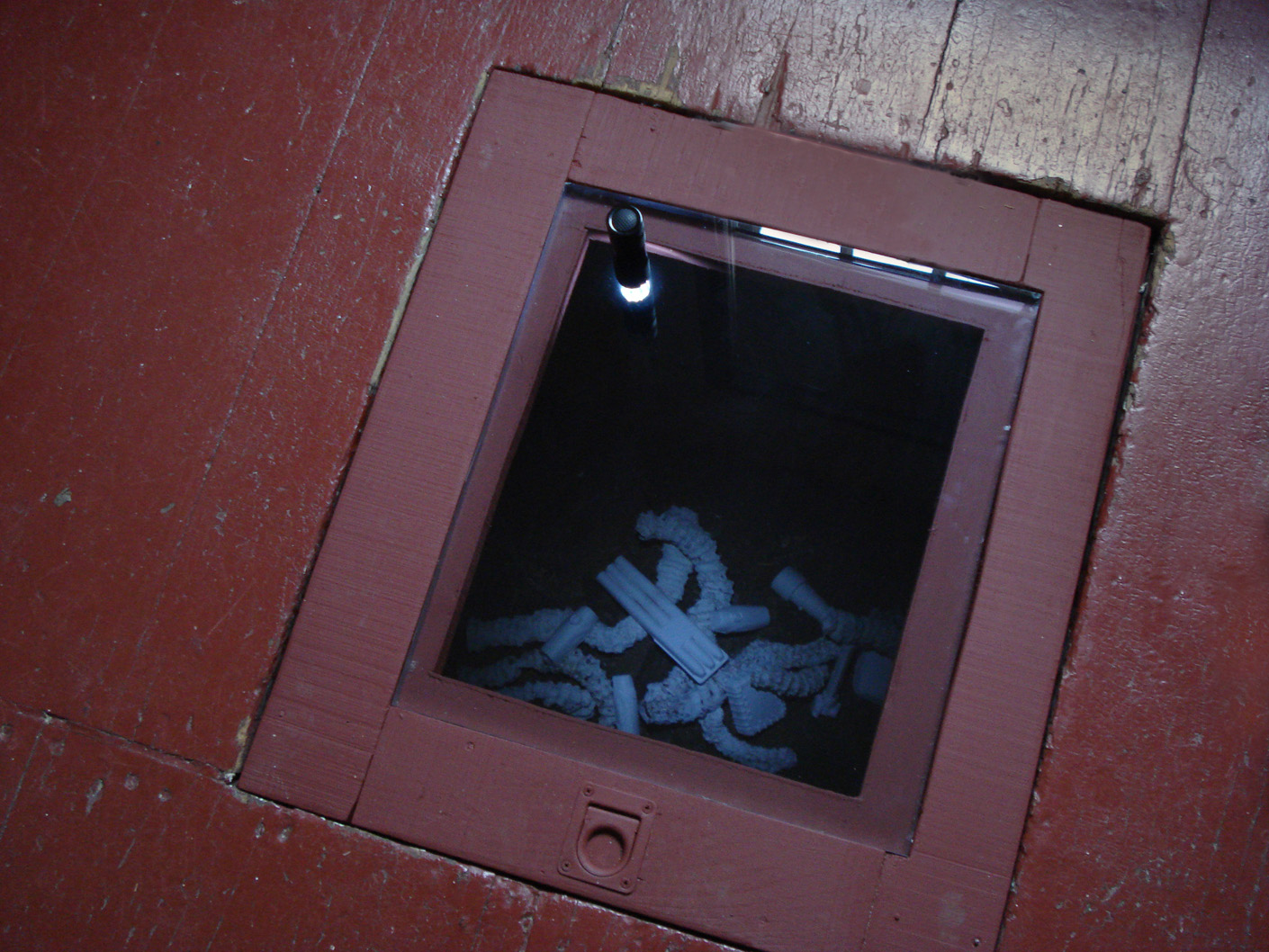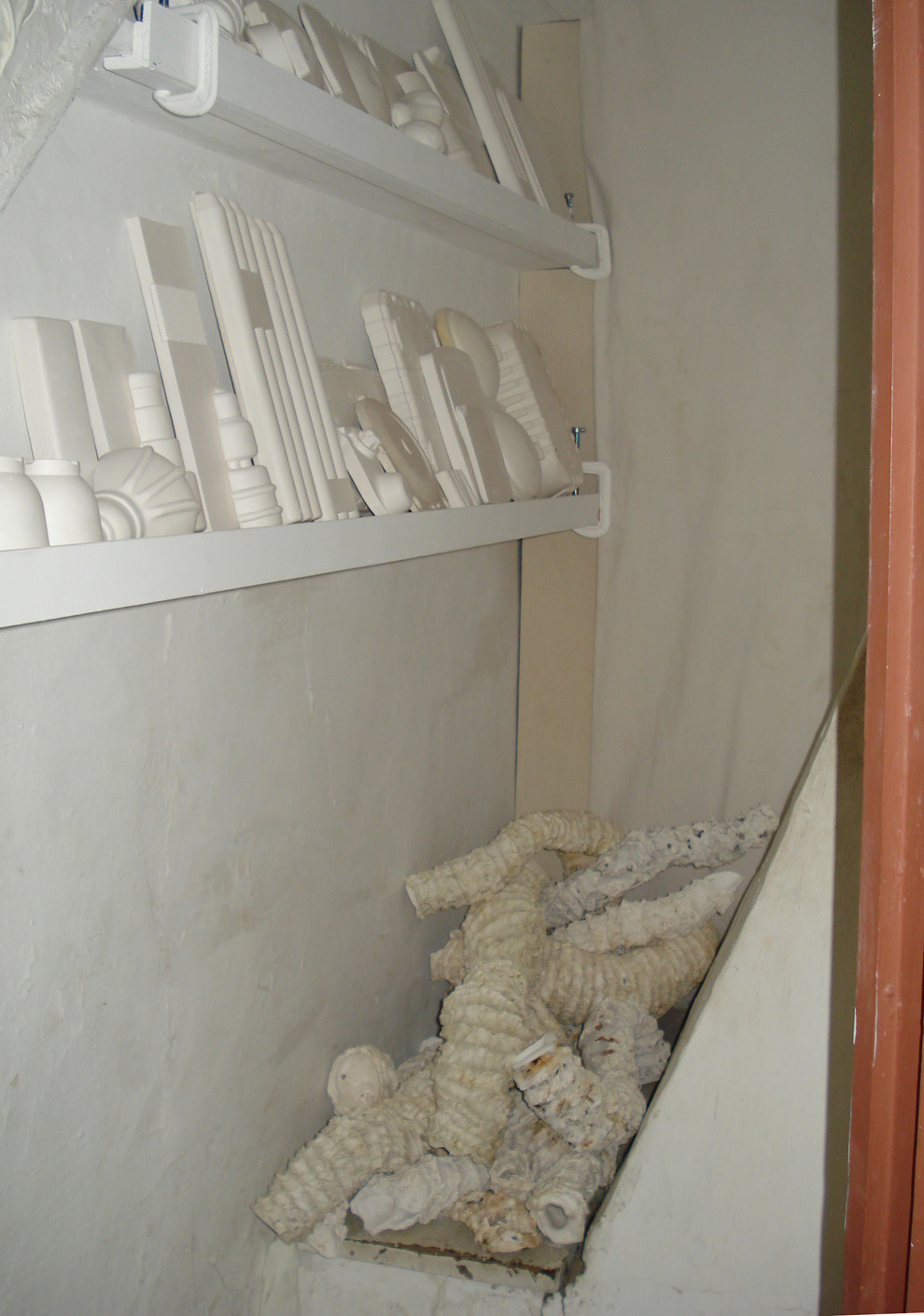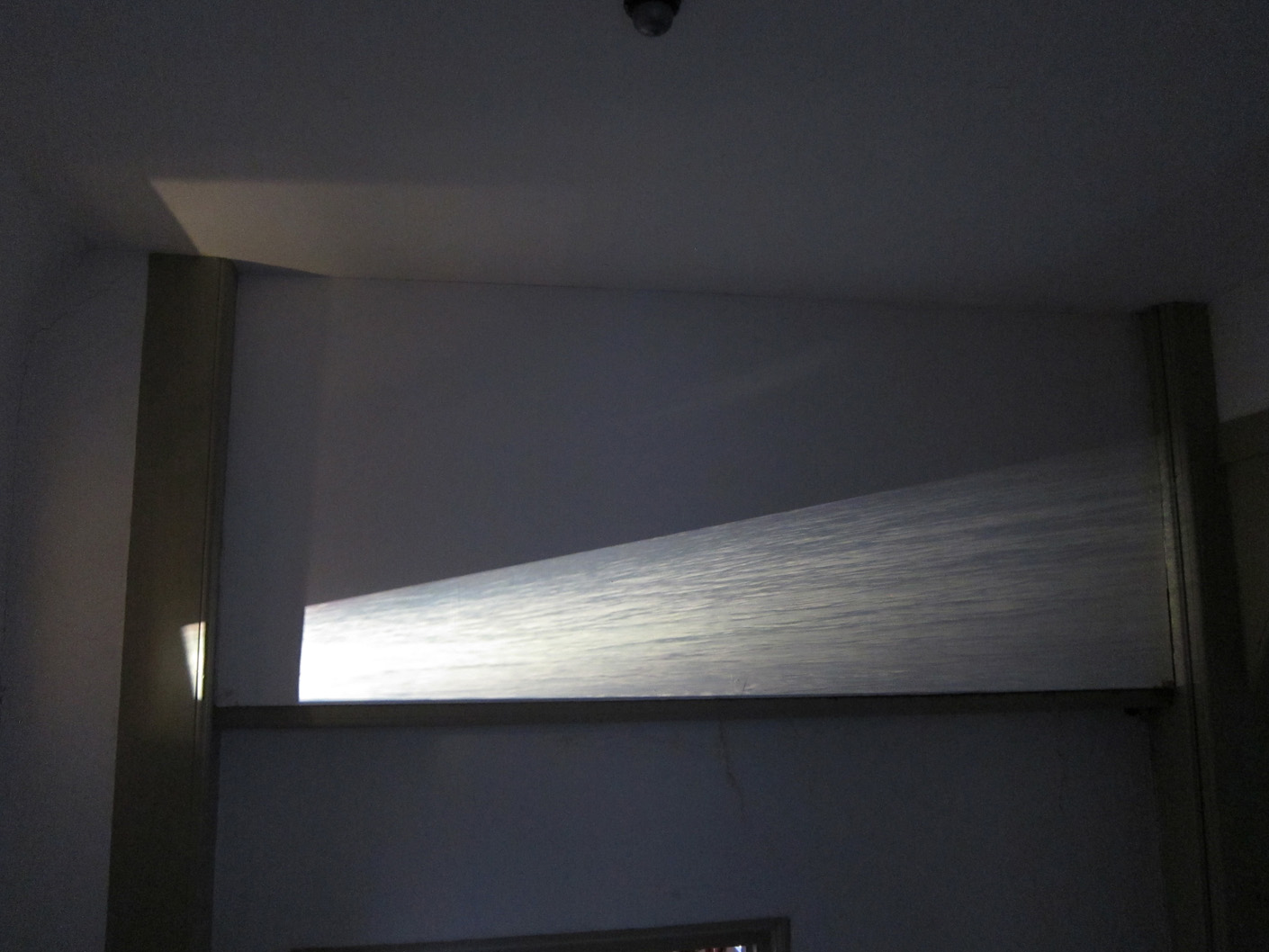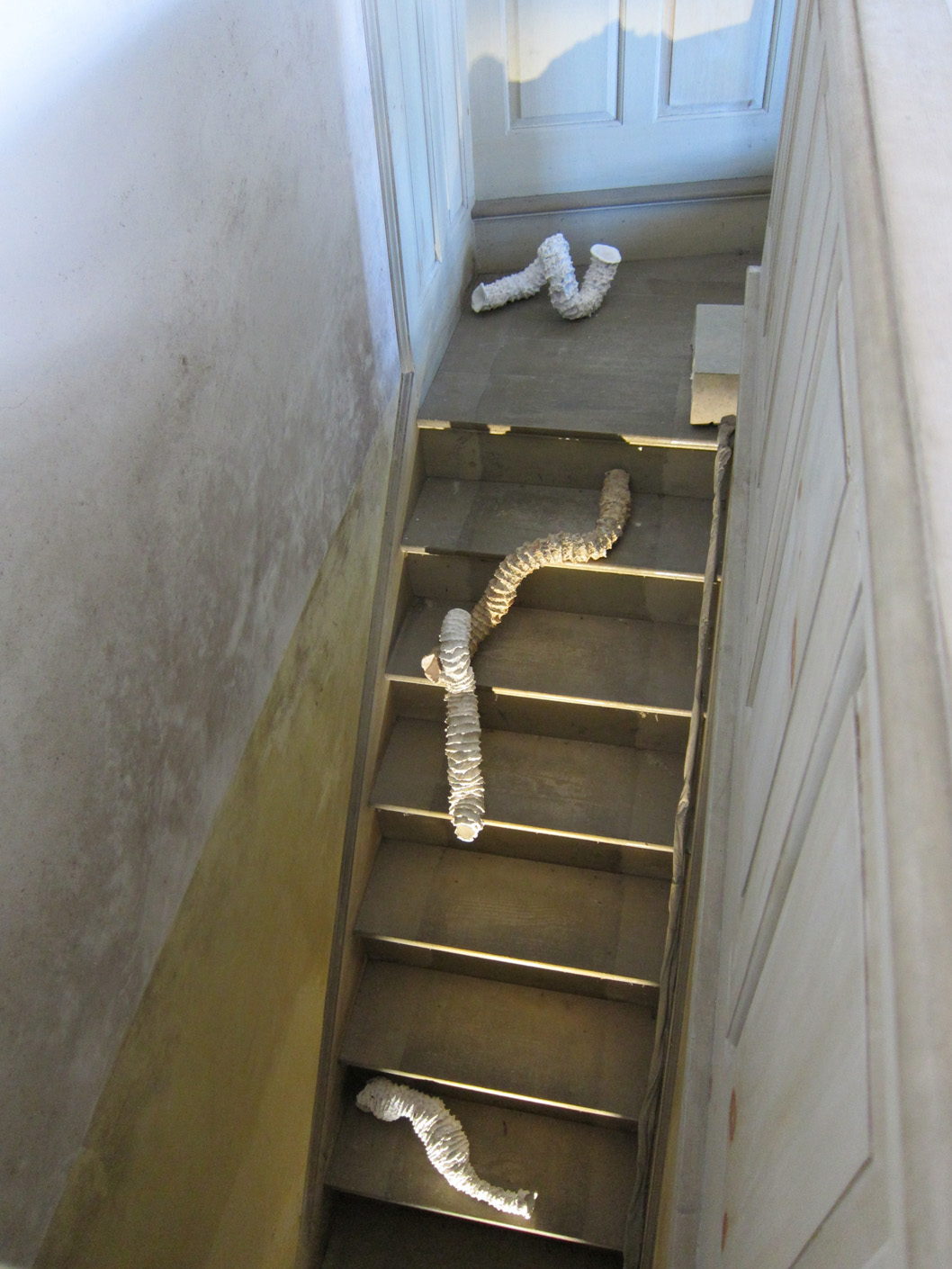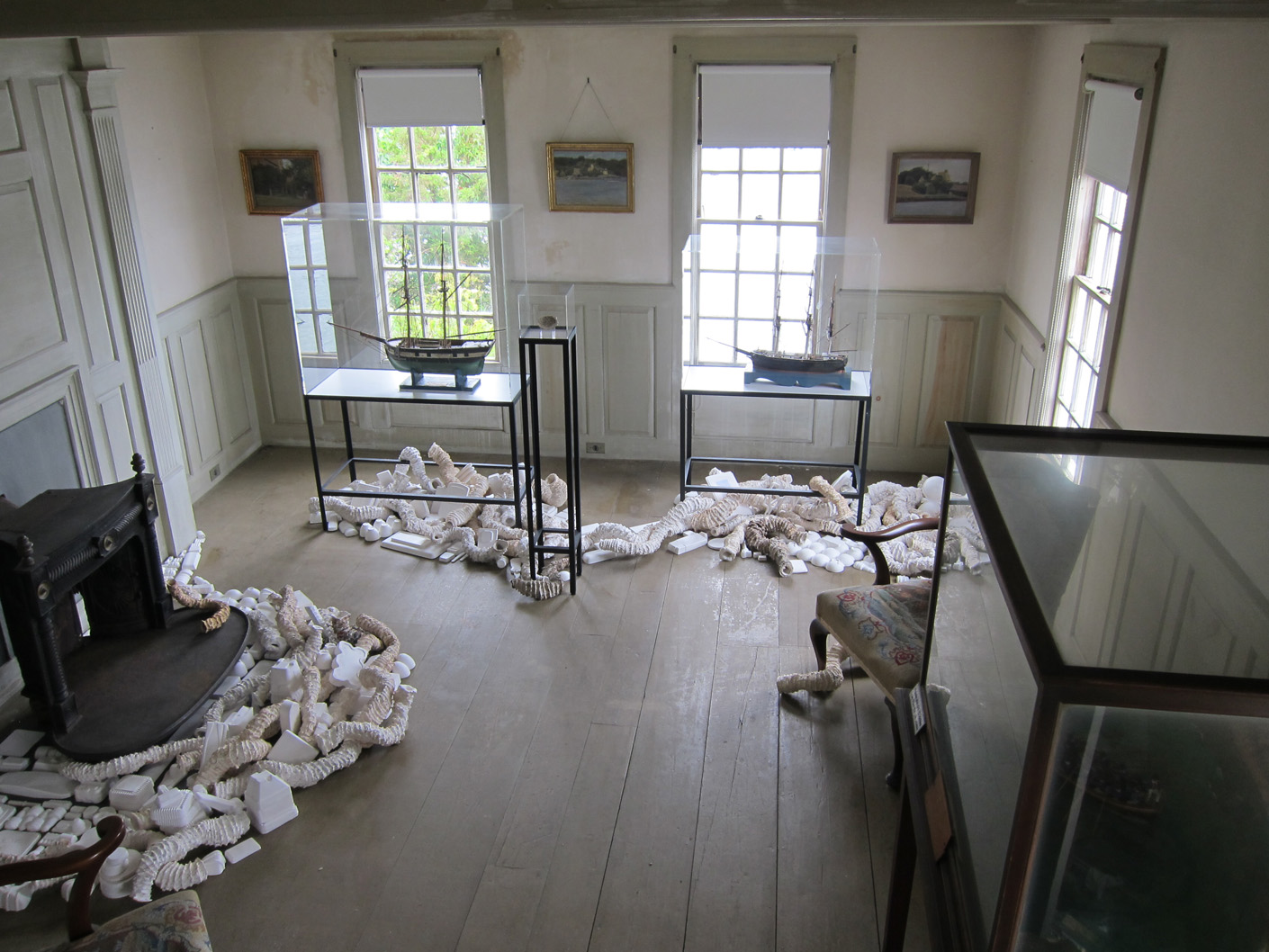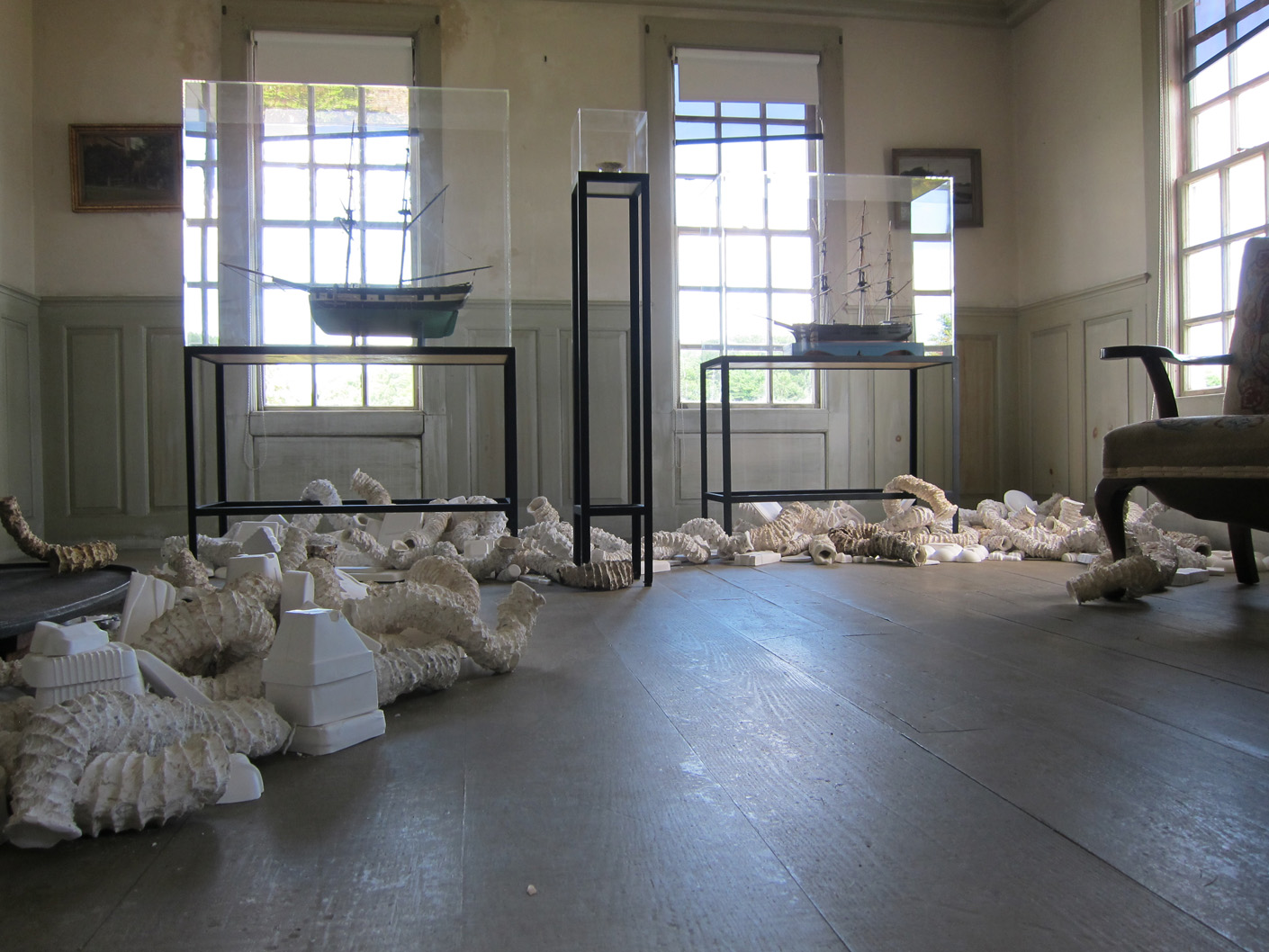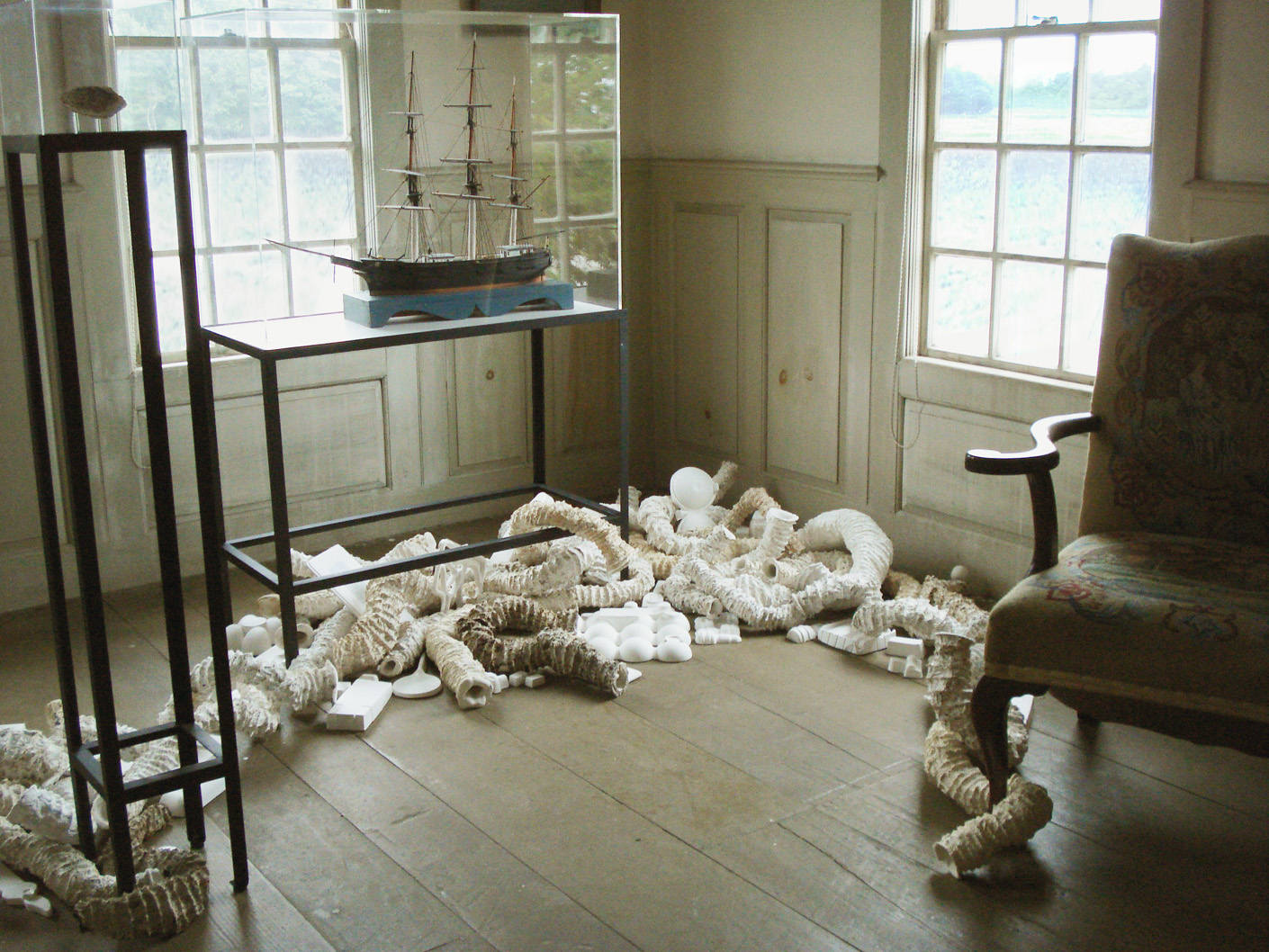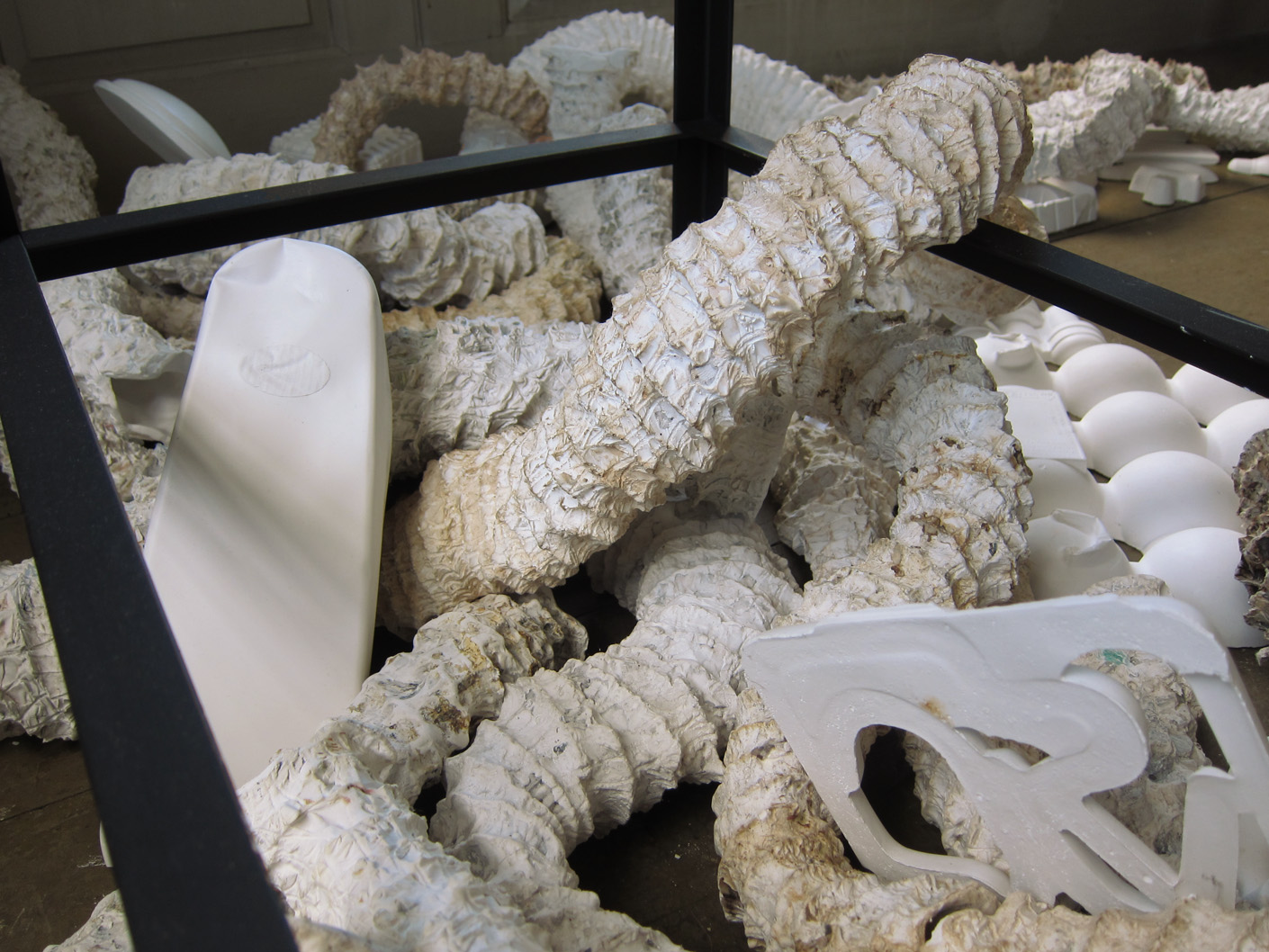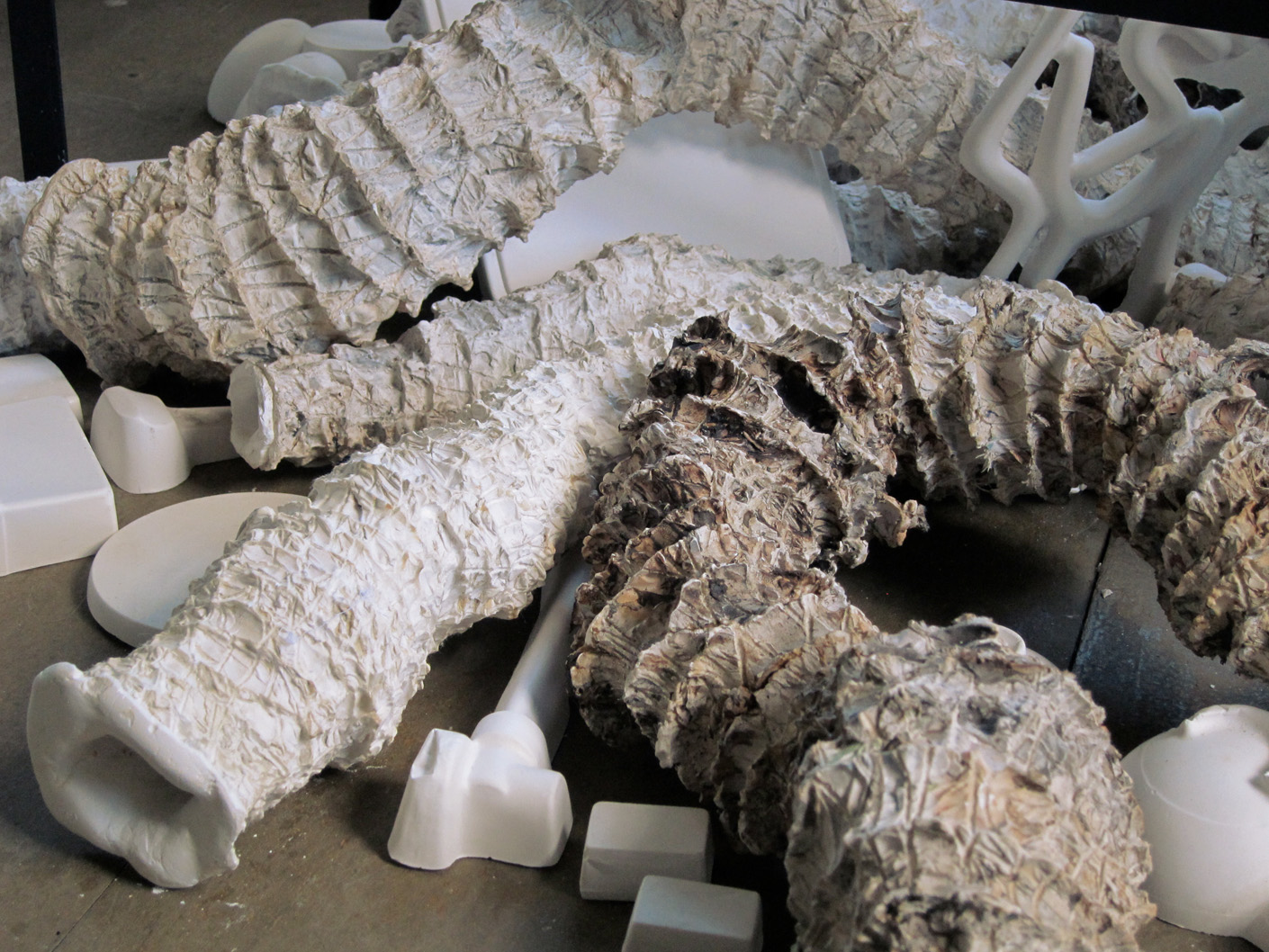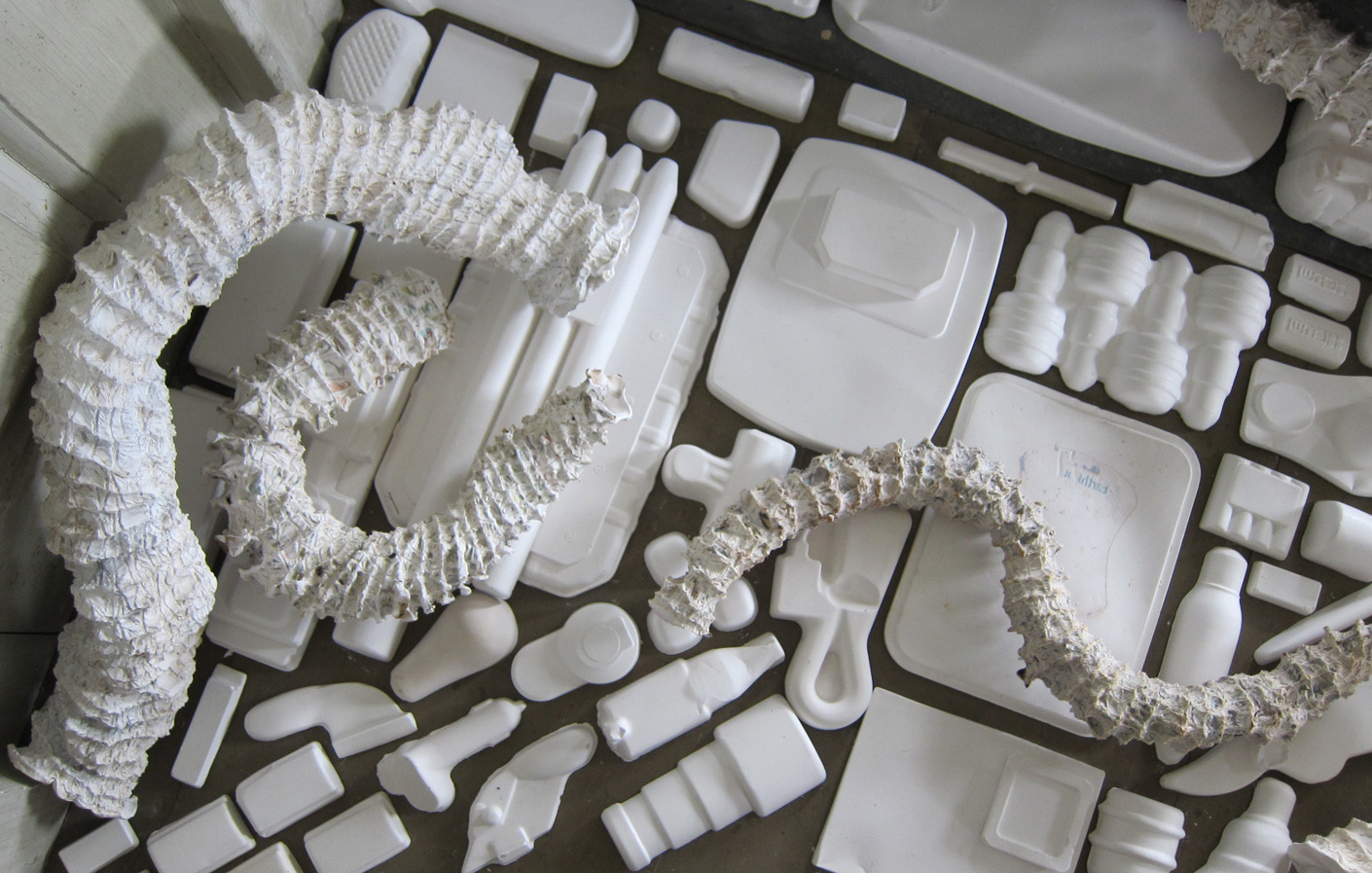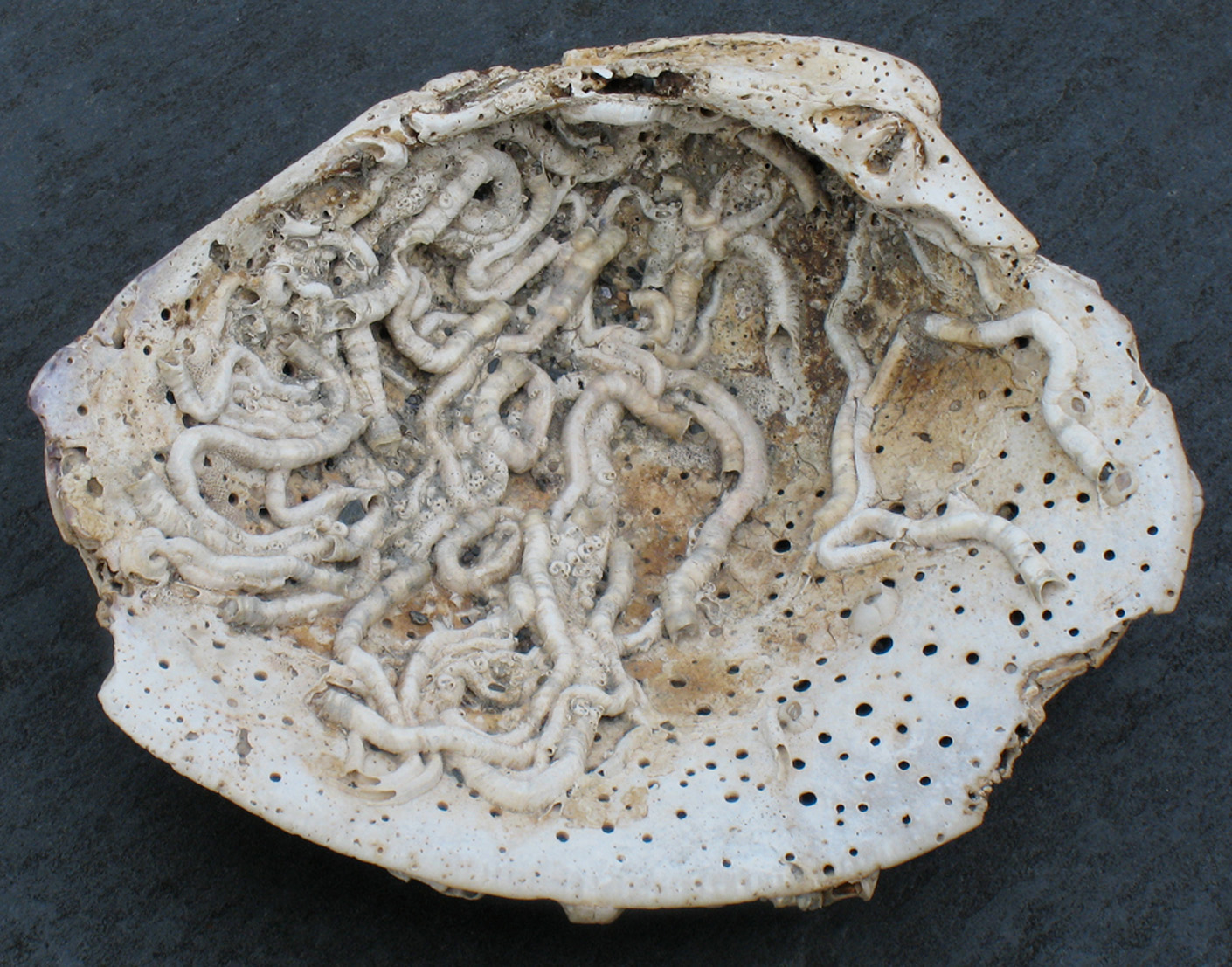“When nature wishes to turn out a hard article of set shape, a support, a lever, a brace, an armor plate; or when it aims to produce a tree trunk, a femur, a tooth or a tusk, a skull or a sea shell, it works in the same indirect way: it takes the liquids or fluids from which all organic matter is made, and slowly separates out the solid substances it needs.”
Paul Valery
Seemingly Unconnected Events
2007- present. Plaster, cast into one-of-a-kind newspaper paper molds (which are burned off) and into non-recyclable plastic consumer goods packaging from personal purchases 2007- 17. A typical cast curving, cylindrical unit with an articulated surface is 12-24”L and approximately 2 ½- 3”diameter, plastic packaging molds are variable, life-sized. Installation dimensions vary according to site, situation and available space. Sound of the sea overlaid with sound of commerce is optional. (Courtesy of composer Robert Carl.)
While walking on the north Atlantic seashore I have often picked up shells colonized by the tiny serpentine habitat tubes of sea worms. To me the curving and twisting lines of these tubes are utterly beautiful, and as seen in the specimen included in the installation, intriguing in detail. These hard limey habitat tubes are the former homes of the sea worms Hydroides Dianthus. In November 2006 The New Yorker magazine published an article by Elizabeth Kolbert , "The Darkening Sea: What Carbon Emissions are doing to our Oceans". The article described the change in ocean acidity due to an imbalance in the reciprocal relationship between the oceans and the atmosphere. This imbalance, described by Kolbert in the “Annals of Science” series, is related to climate change, which is causing our oceans to become less basic, and hence, endangering some creatures living in calcium-based structures, like the sea worms and coral reefs. Kolbert's article discusses similarly tiny pteropods in detail. Since I was, at the time of reading the article, intrigued by the calcium-based creature habitats of the sea worms, I began to envision a project made from hundreds of larger-than -life homages to this tiny life form. The sculpture also acts as a record of my consumerism over more than a decade.
The hundreds of plaster modules have been adapted to different sites and situations. When located in a gallery setting I have stacked and interlaced the units to create metaphorical forms such as The Wedge (as in “just the thin end of the wedge”), Cubed (as in “the problem squared or cubed”), The Squeeze (a sort of cityscape), and Washed Up (a scattered mound). The most recent installation was in the Red Barn Gallery at the Land Institute in Salina, KS. Titled Seemingly Unconnected Events: The writing is on the Wall, the piece is a collaboration between myself, Wes Jackson-co-founder of the Land Institute, writer and plains historian Aubrey Streit Krug and philosopher Bill Vitek. Together we selected a series of texts that added another layer of meaning to the exhibition. In effect the writings attempt to connect various events such as consumerism and climate change. The words of Wendell Berry, Vandana Shiva, Gary Snyder, Stan and Paul Cox, Elizabeth Kolbert, and others, join Wes Jackson’s writing scrawled in mud on the walls and ceiling of the galleries.
Both galleries in the Red Barn have built in bookshelves. A woodstove in one gallery inspired the idea that the two rooms might posit counterparts of global climate change—heat, fire, and drought in one room, water, floods and washed up debris, in the other. Charred newspaper fragments are literally rammed into one bookcase, and in the other nature seems to have become the source of knowledge as the sea worms seem to have wriggled into the book cases, sometimes showing a vertical spiny back to the viewer, as in book spines. The use of the charred organic newspaper molds themselves, along with singed consumer goods, ash and cracked earth convey aspects of extreme heat in the first gallery. There is a window between the two galleries and the charred sea worm forms appear, somewhat humorously, to climb and topple over each other over in an effort to get through the window. As these charred life-form icons pass from one space to the other, they begin to shed their external charred skins, perhaps trying to be like their counterparts in the watery space. That room is marked all around with a muddy waterline similar to that left behind after a flood. The objects in the space are white or whitish with their singe marks washed or eroded. In both galleries the floor is slanted from its former use as a barn, though the angle is more pronounced in the second and larger gallery. Here, hundreds of consumer goods are pulled down the ramped floor, as if by gravitational force and the aftermath of retreating waters.
Here use some quotes from the texts
The first installation site was in the Wentworth-Coolidge State Historic Mansion in Portsmouth, NH.There, it was situated throughout the house in niches, closets, a subterranean space, a stairway and in a room overlooking a bay of the North Atlantic. There was also a projection titled New Sea Level and a sound piece. Our agreement with the historic site was that we could move objects around in the rooms but not remove anything. I choose to create new gallery furniture for the ship vitrines in my main installation room and utilize the vitrines to integrate the historic objects with the contemporary sculpture, as they also made reference to the sea which could be seen and felt through the windows of the room itself. The plaster seaworm forms and consumer goods casts crawled, sprawled and collected around the bases of the vitrines, historic furniture, descended or ascended a set of stairs and seemingly organized themselves on the floor of the room and around its woodstove. The sound of the ocean overlaid with the sound of commerce emitted from a subterranean chamber at the base of the stairway.
Seemingly Unconnected Events, it all its formats, stems from activities prominent in my art-making process: reading, walking, collecting and an intense interest in making. It is also related to my desire to explore making sculpture using materials and processes that are safer for the environment and for the human body. My process, like that described by poet Paul Valery, is to slowly separate out the things I need to form my work within the multi-layered context of the world. To create curving forms reminiscent of the Hydroides Dianthus habitat structures I coil newspaper into molds. Plaster is poured into and out of the interiors of the curving cylindrical paper molds to create hollow plaster tubes inside. The technique yields complex surface markings that parallel, though do not duplicate, those on the sea worm habitat tunnels themselves and is intended to create sculptural forms that contain some of the detail and beauty of the originals. This is a labor-intensive process and yields paper molds may be used only once since they are burned off the positives. The white plaster positives retain faint impressions from the newspaper and burning. The casting material, plaster, is itself primarily calcium and similar to the Hydroides Dianthus casings in constitution.
Simultaneously with the above activities, I began to save the plastic packaging from products I purchase. I had often had noticed that these plastic packages were ready-made casting molds and, when cast into objects, could provide a sculptural record of my consumerism. Pairing the beautiful organic forms of the sea worms with these stripped down man-made forms creates a striking and telling combination. Kolbert's article concludes as follows, and is the source of the title, as well as influencing the content, of this work: "As the process of ocean acidification demonstrates, life on land and life in the seas can affect each other in unexpected ways. Actions that might appear utterly unrelated—say, driving a car down the New Jersey Turnpike and secreting a shell in the South Pacific—turn out to be connected. To alter the chemistry of the seas is to take a very large risk, and not just with the oceans."
